The Rainbow Portrait and A Lover’s Complaint
More Evidence of the Catastrophic Failure of “Professional” Elizabethan Scholarship
by Steven Steinburg
August 30, 2019

[dropcap]I[/dropcap]N THE MISINTERPRETATION of the ‘Rainbow Portrait’ of Queen Elizabeth I, and A Lover’s Complaint by ‘William Shake-speare,’ we find exemplified a failure of scholarship that is, in a word, mind-boggling. It is not simply that thousands of ‘professional scholars’ have been wrong about Shakespeare. For the Academy, and the venerated idea of professional scholarship, that would be cataclysmic enough. But, the failure goes far beyond Shakespeare, and far beyond what even my Oxfordian colleagues have been willing to contemplate.
My claims will be greeted with skepticism, as they should. I would prefer to begin less ambitiously, less sensationally, to take one small step at a time. But it is not possible. All Elizabethan things are connected. In a perfect world what I am sharing here, and what I am about to reveal in several books, should be subjected to intense peer study and review, and not presented unceremoniously as if they are just more musings on what has become the eternal Shakespeare authorship question. Humbly I say I do not have the time or resources. These discoveries are, in my opinion, too important to wait. Review will come. There will be corrections and improvements. With time the truth will be ironed out. Let the debate proceed.
This essay seeks to begin a total revision of our understanding of the Elizabethan era and the man who was the invisible literary giant of one of the greatest literary eras the world has ever seen, and perhaps the single greatest intellect that ever put pen to paper. He was far more than Shakespeare. Far more. The man I am speaking of is Edward de Vere, 17th Earl of Oxenford. I will refer to him as Oxford, though we could simply call him O.
How could it be? How could thousands of scholars be that wrong? How could a failure of such magnitude be possible? The simple answer (though certainly not the complete answer) is the notion that title page attributions must be taken at face value. Exceptions are allowed, but only to preserve orthodoxy. Title page attributions define the interpretive context for Elizabethan scholarship. I would qualify that to say, Elizabethan literary scholarship, except that the misinterpretation of Elizabethan literature, and misattribution, has utterly perverted biographical and historical interpretation for that era.
‘Context is everything’, as the adage goes. It is the key. Take Elizabethan title page attributions at face value and everything that follows is misinterpretation. Interpretive context is crucial to understanding! Therefore, I hope to give the reader enough of the essential interpretive context (as I have interpreted it) to apprehend what is argued here. The argument is divided into a number of parts which, I hope, achieve a degree of narrative linearity. I hope it will be understood that overlap and redundancy is necessary. This essay is a kind of introduction. It is not the argument.
There is, so far as I have found, little if any non-orthodox scholarship on the Rainbow Portrait or the poem A Lover’s Complaint. Oxfordians have been surprisingly silent on both. Prince Tudor (PT) theorists, it would seem, would have drawn a connection to the portrait’s inscription: ‘Non Sine Sole Iris’. In English, ‘No rainbow without the sun’. A simple homophone converts the English translation to, ‘No rainbow without the son’. This could refer to Henry Wriothesley, or to Oxford, subject to the PT theory one prefers. I prefer the latter and that is the direction of my argument. However, the arguments here should not entirely disappoint advocates of the Wriothesley theory. But (and this is important), the phrase, ‘No rainbow without the son’, can also be taken as, ‘No rainbow without the Son of God’. The ‘son’ of a ‘virgin’. Please make a note.
Knowing the skepticism this essay will encounter, I must, for the sake of interpretive context, be candid. I have discovered overwhelming evidence that Oxford and Henry were both sons of Queen Elizabeth. Oxford was not Henry’s father. The father, in both cases, was Robert Dudley. That’s what the evidence suggests. And those brothers had a sister by the same father and mother. Wriothesley PTers may find a way to construe the evidence here to serve their theory. And there are, I know, many Oxfordians who reject all PT theories. God bless both their houses. I say that sincerely. But I humbly suggest they take the time to consider the arguments here, for this is a door to a new understanding of Oxford’s authorship. As for Stratfordians, and ‘professional Elizabethan scholars’, it would take a miracle to cure their institutional intellectual rigor mortis. I’ll not presume to work miracles. But, now to the matter at hand.
The Portrait and the Poem
Among the ‘professional Elizabethan scholars’, Roy Strong is perhaps the most recognized ‘expert’ on the Rainbow Portrait. He says:
All scholars are agreed that it can be dated to about 1600, which would indicate that it was commissioned by Robert Cecil, later Earl of Salisbury.[1]
The problems begin. It is true. ‘All scholars are agreed’, more or less, that the painting dates to 1600-1602. That is close enough for my purposes. And nearly everyone agrees that Robert Cecil ‘commissioned’ the portrait. Now we have a major disagreement! That is impossible. I say that with a caveat that I will discuss at the very end. The true meaning of the portrait tells us the motive behind it, and that motive tells us who it was that masterfully conceived that Trojan horse. That person could only be Oxford, the secret and profoundly frustrated son of the queen. And this tells us, among other things, that Oxford’s artistic genius was not limited to words.
One tell-tale sign that this portrait was, and is, a Trojan horse, is that it bears neither a date nor a signature. Why would the artist of such a marvelous and provocative portrait not want to take credit for his work? True artists are generally good judges of their own work. The painter of the Rainbow Portrait undoubtedly recognized that that painting was one of his most important works, and that, for the purpose of future commissions, it would be excellent advertising. But, he also knew that that painting was not just a Trojan Horse, but a ticking revelation-loaded time bomb. The anonymity of the artist served to protect the artist in the event that bomb went off prematurely, and it ensured that people wouldn’t be able to put troubling questions to the artist, for a while at least. Word eventually leaked out that the artist was Marcus Gheeraerts the Younger. By then the Trojan horse was a glorious success. Everyone loved it, especially the queen, although, if the dating we have is correct, she died only a few months after viewing the portrait. But, she’d never looked so gorgeous. The artist sighed a sigh of relief. The bomb would go on ticking for some four hundred years.
The Rainbow Portrait has not been regarded, by Stratfordians or Oxfordians, as relevant to the Shakespeare authorship question. Although orthodox scholars have not felt particularly compelled to find explanations or interpretations that are congenial to the Stratfordian tradition, they have been guided by the necessity of devising explanations that do not upset the conventional wisdom, at least not too much. As we shall see, not all of the interpretations have been entirely conventional. Valerie Traub sums up the generally agreed upon starting position:
Even as this notoriously enigmatic painting interweaves a complex skein of religious and political allusions, two aspects of its iconography are particularly relevant to our consideration of Elizabethan eroticism: the disembodied eyes, ears, and mouths arrayed on top of her clothes, and the colorless rainbow in Elizabeth’s hand.[2]
‘Colorless’. Please make a note. But, I have two important objections to the above. First of all, the idea that examining this painting through the lens of ‘Elizabethan eroticism’, or ‘Elizabethan gender perspectives’, as it is sometimes referred to, illustrates what happens when academics are constrained by an interpretive context that is uniquely fraught with ambiguity and paradox; that is, where authorial disconnection is the norm. I would say, take Shakespeare for example, but, though it has hardly been noticed, the problem extends beyond Shakespeare, to Sidney and Spenser, and many other names. Since the ‘professional’ scholars cannot find the biographical authorial connections and cannot link the works to personal interests and motives, they resort to explorations of cultural generalities. The result is an academic dead end and literally tons of academic drivel.
Getting back to the example at hand, my second objection is that Traub cannot see the forest for the trees. In a discussion of graphic symbolism, where details are extremely important, she makes the amazingly erroneous statement that the, “eyes, ears, and mouths arrayed on top of her clothes”. No they are not! Those ‘eyes, ears, and mouths’ are on the liner on the inside of Elizabeth’s cloak! The inside! I will repeatedly come back to this, for it is absolutely central to the meaning of the portrait and to discovering the purpose and motives behind it.
On the matter of the mouths (that Traub does see), expert opinion is split. The mouths are a problem. Roy Strong decided the matter this way:
A detailed examination of this garment shows no signs of the mouths read into it by scholars . . .[3]
A ‘detailed examination’? How? By whom? We’ll come back to that as well. Traub is certainly correct that the portrait is ‘notoriously enigmatic’. Everyone will agree to that. She is misguided, however, in her assumption that the true meaning can be accessed by way of religious and political allusions, or even, as she proposes, by way of erotic symbolism (intentional or unintentional). In fact, as we shall see, the evident religious and political symbolism in the portrait are merely the first level of meaning aimed at naïve viewers, like Strong, and even Traub or Fischlin, who are bolder in their reading of the portrait.
The most obvious problem with the portrait is not any particular symbol, but the ambiguity of the symbolism. This fact alone should have set off warning bells in Robert Cecil’s head. Robert Cecil was Elizabeth’s Secretary of State. But he was also, secretly, her Lord High Minister of Spying and Propaganda. He’d learned from the best, his father, William Cecil, Lord Burghley. Robert Cecil may not have been sophisticated in his knowledge of symbolism, but he understood how to use symbolism as a tool of propaganda. For his purposes symbolism needed to be easily understood. He understood the danger of ambiguity. It is a mystery, therefore, that the Rainbow Portrait ever saw the light of day, let alone remained on proud display.
It was too beautiful! Especially compared to all the other portraits of Elizabeth. It is sumptuous! One look at that portrait and you fall in love. The beauty of that portrait and its instantly addictive effect tell us something about the person who designed it. And there was a good cover story.
It’s one thing to throw a bunch of symbols together. It’s another thing to weave such symbolism into a magnificent dramatic work of art with a coherent underlying narrative. Expert opinion now tends to the identification of Marcus Gheeraerts as the artist, and I will provide evidence (new I think) that he was in fact the artist.
Gheeraerts was an accomplished artist, but he is surely not the person who composed that portrait or devised the details. And that person was surely not Robert Cecil. He had neither the artistic sense nor the motives. This is an extremely important point. Unless we have totally misread Robert Cecil’s motives in the final years of Elizabeth’s reign, his went quite the opposite direction. This has not occurred to the scholars even though they have observed many things about the portrait that seriously conflict with the assumption that Cecil commissioned it. It seems to me that scholars who have, with seeming authority, commented on the portrait, have very little understanding of the historical-biographical background.
A few years after the portrait went on display a little ‘book’ appeared with the title William Shake-speare’s Sonnets. You may have heard of it. Near the back, almost hidden, unmentioned on the cover or title page, was a 47 stanza poem called A Lover’s Complaint. Here’s what the attribution on the first page of the poem looked like in 1609 (figure 2):
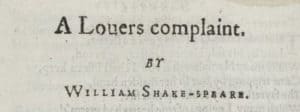
Note the small print used for the name. I’m guessing that was the smallest print-type available or possible at the time. The poem didn’t get much attention. It didn’t seem like much of a poem. To lots of folks it didn’t even seem much like Shakespeare. Not long ago Ron Rosenbaum described it as a “bad” poem.[4] Some scholars have deemed it so ‘bad’ they refuse to accept that Shakespeare wrote it. Breaking the most sacred rule of Elizabethan literary scholarship (‘Title pages don’t lie’), Brian Vickers overrules the explicit attribution of the poem saying:
Shakespeare did not write A Lover’s Complaint, and the sooner it is removed from his canon, the better. The real author, as I have argued, is the prolific but mediocre poet and writing-master, John Davies of Hereford.[5]
John Davies was a ‘mediocre poet’. However, Brian Vickers’ dubious methodology, and his depreciating contributions to ‘attribution studies’, if believed, would make attribution and authorship meaningless. But then, the Stratfordian Tradition has already done that for Shakespeare. However, as it relates to the Rainbow Portrait, Vickers’ assertion that John Davies was the author of A Lover’s Compliant turns out to be a curiously coincidental proposition, as we shall see.
Until two years ago I did not think that A Lover’s Complaint was important. I don’t think any of us Oxfordians thought it was important. I would have agreed with Rosenbaum that it was “bad”; not worth the time. That assumption, my friends, was a monumental mistake (in a double sense). I’m only going to touch briefly on that monumental poem in this article, and I don’t expect to convince the reader at this time, but A Lover’s Complaint, I confidently assert, will come to be regarded as one of most important literary works of all time, not as poetry, but as an utterly unique form of narrative that tells a history-changing story.
To understand that poem there are a couple of things one must understand about Oxford. I know that sounds presumptuous. Bear with me. We, Oxfordians, have not had a proper appreciation of his playfulness, his often risqué sense of humor, his incessant use of riddles, or the scope of his genius, nor (this is vitally important) have we understood his motives or the depth and sincerity of his humanity. We have not understood his desperate need for authorial connection, and how he has been reaching out to you and me. And there is the huge problem that there has been no understanding of his method of concealed storytelling, what he called his science. For an introduction to that science I refer the reader to my recently released book, Renaissance of Lies. For an in-depth discussion of A Lover’s Complaint, please see my other soon-to-be released book, Resurrection.
Wishy-Washy Scholarship
With the possible exception of the Coronation Portrait, the Rainbow Portrait is by far the most flattering of Queen Elizabeth’s portraits. It is, to be sure, the sexiest. Elizabeth was nearly seventy at the time it was painted (per the generally accepted dating), and she obviously didn’t stand model for this portrait. One of the models was most probably this slightly earlier portrait which I place side by side with the Rainbow Portrait (figure 3):
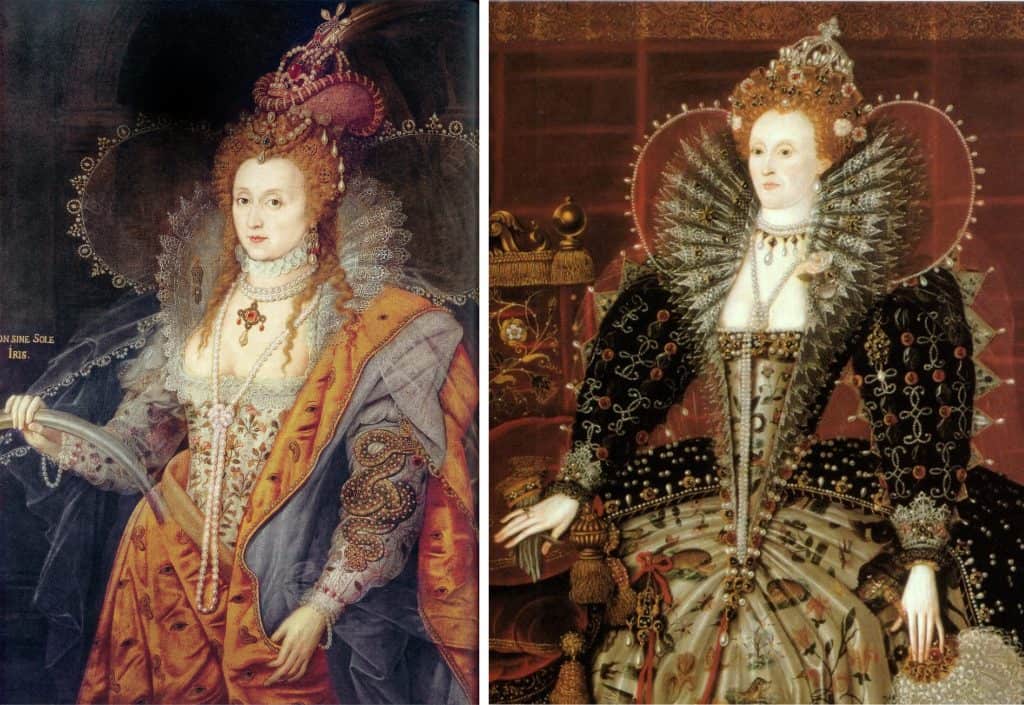
Both portraits appear to use the same or very similar wig (an important point). Both use the same long pearl necklace (another important point). Both use a similar huge gossamer wing-like apparatus, etc. In contrast, however, Elizabeth’s gaze in the Hardwick is off to the side, cold, almost disdainful, disinterested in the viewer. The lady’s gaze in the Rainbow Portrait is direct, warm, and alluring. Notable are the three strands of hair that ‘descend’ along the cheeks onto the breast in the Rainbow Portrait (another important point!). By contemporary standards, ‘loose hair’, ‘loose woman’, generally speaking. The ‘loose hair’ is unique in Elizabreth’s portraits except for the Coronation portrait and certain cameos. The torso in the Hardwick is stylized in a stiff unnatural cone-shape. The bosom is flat. In the Rainbow Portrait the upper torso is natural and there is a visable plumpness of the breasts. One can almost see the nipples.
Comparing Elizabeth’s face in the Rainbow Portrait to her many other portraits, the painter has taken considerable liberty in enhancing her appearance. In the Rainbow Portrait the head is proportionately larger, the face is wider, the eyes are larger, wider set, and more expressive. In the Hardwick the head and face are slightly pulled back as if in recoil. We see the typical pale pastiness that came to characterize the queen. In the Rainbow Portrait the paleness is deemphasized and the facial appearance is more natural. There’s nothing ‘corpse-like’, ‘ghostly’, or ‘carcass-like’ about the lady in the Rainbow Portrait. That woman is confident but relaxed, vital, sensuous, and alluring. The cloak is sumptuous. The colors are warm and welcoming. It is undoubtedly the most convivial of all of Elizabeth’s portraits. Forgive me if I am pointing out what is obvious.
In describing the scholarship on the Rainbow Portrait I would use words like speculative, superficial, naïve, even sloppy, but most of all I would use the technical term, wishy-washy. This is true of Elizabethan scholarship in general. Wishy-washy! Let us set forth with Frances Yates who serves as the starting point for most of the available scholarship on this painting:
If the portrait of Queen Elizabeth I at Hatfield House, usually called the ‘Rainbow portrait’…is placed beside Boissard’s plate of a ‘Sponsa Thessalonicensis…it is immediately apparent that the curiously-shaped upturned head-dress of the portrait, with the striped rim and surmounted by an aigrette, has been suggested by the head-dress of Thessalonica. The flowing mantle worn in the portrait, and the position of the hand which raises it, might also have been suggested by Boissard’s figure…. The allegories of the picture are also highly applicable to Elizabeth: the rainbow shows her as a peace-bringer; the eyes and ears with which the robe is covered alluded to her fame; the serpent on the sleeve indicates her wisdom; and above the serpent’s head is the celestial sphere, encircled with the band of the zodiac, which is a symbol elsewhere found in connection with Elizabeth (for example in the ear-ornament which she wears in the Ditchley portrait).
The clue to this picture may be that it records Elizabeth’s presence at some masque in which allegories in her honour were presented by various personages but which are now summed up in a composite portrait of herself.[6]
There are a number of important points I want to emphasize: 1) Yates detected the connection of the ‘headdress’ in the portrait to the figure of Sponsa Thessalonicensis in Jean Jocques Boissard’s ‘costume book’, Habitus variarum orbis; 2) Yates noted that the figure in the headdress is a bride and that the hat is a bridal headdress.[7] However, Yates does not address the problem presented by a virgin queen wearing a bridal headdress; 3) Yates noted the ‘striped rim’ of the headdress; 4) Yates says that “the eyes and ears with which the robe is covered alluded to her fame”. However, Yates does not mention mouths; 5) Yates says that, “the serpent on the sleeve indicates her wisdom”; 6) Yates concludes that the various features of the portrait may represent a ‘composite’ from costumes worn at an event attended by the queen.
Yates ignores the problem of the bridal hat and explains very little about the portrait and the motives behind it. It appears that, within the alleged ‘composite’ nature of the costume and symbols, Yates takes some of the symbols to be simple decoration. This is very important. If she’s right, the symbolism of the portrait should not be taken too seriously. Interpretation of the portrait is, then, a harmless pastime. It seems to me that, given that the portrait practically screams at the observer to study its symbolism, the inclusion of simply decorative (and inherently contradictory) symbolic elements is counter-intuitive. René Graziani observes:
As well as being one of the most radiant images of her, this portrait is one of the most insistently symbolic. Was the sense meant to be plain or is it calculated to be obscure? [8]
I would say, ‘insistently and intensely symbolic’ and ‘obviously obscure’. The portrait is, in a word, provocative. If we are inclined to reject wishy-washy explanations, we ought to grant that the mastermind behind that obscurity and the provocation knew exactly what he was doing; and I think it is logical to assume that the portrait’s use of symbolism is intended to be meaningful and congruent in the story it tells. The painting is too intense in its projection of meaning, too precise and complex, too obviously intentional in its provocation, to allow a loosy-goosy explanation about commemorating a ‘costume event’.
While scholars have more or less embraced Yates’ ‘composite’ explanation, the main focus of scholarship on the painting has been, nevertheless, to guess the meaning of the problematic symbolism. It ought to be obvious that such explanations require a theory as to the persons and motives behind the portrait. This has not been obvious to the scholars. They don’t even mention it. They persist in the improbable assumption that Robert Cecil commissioned the portrait. This exemplifies the superficiality of the available scholarship. And so it is that the orthodox scholars have naively rolled Oxford’s Trojan Horse into their orthodox city.
Getting down to details, the biggest most obvious specific problem are the eyes and ears and mouths on the marvelous orange-golden liner of the cloak. I say again, on the liner! For these provocative features, scholars have come up with three principal explanations: 1) they represent Elizabeth’s ability to ‘see all and hear all’; 2) they represent her fame; 3) the symbolism of the portrait is a hodge-podge ‘composite’ and doesn’t mean anything in particular.
And then there is that strangely colorless rainbow. That, too, has generated some very interesting interpretations. All of this, among the scholars, remains unsettled. However, I think it is fair to say that no one is losing any sleep over it (though they should). In the minds of the ‘professional scholars’, the portrait is just another unimportant Elizabethan mystery. That said, a few of those scholars have ventured down some surprisingly exotic, erotic, and not entirely benign paths. Take, for example, Valerie Traub:
Increasingly, the rainbow is interpreted not only as a royal scepter but as an ambivalent image of phallic power (bent, nor erect), while the open mouths, ears, and eyes, along with the folds of the mantle itself, have been viewed as disturbingly vaginal. For Susan Frye, these body parts “form a disquieting suggestion of vaginal openings,” while Joel Fineman calls attention to the “salacious ear that both covers and discovers the genitals” of the Queen. For Daniel Fischlin, the “ambiguous folds, in combination with the vague phallic rainbow and the string of pearls looped suggestively round Elizabeth’s genital area, image an erotic potential complicit with the sovereign vitality the portrait projects. Elizabeth’s metaphorical embrace of the phallus, whether construed as an assimilation and erasure of masculine power or a prosthetic supplement to her own body, confirms her status as actively desiring, erotically commanding, and self-pleasuring. The relative position of the rainbow and hands enhances this reading: just as the visual line of the rainbow fades toward the genital area, the thumb and bent index finger of Elizabeth’s left hand are inserted into the folds of her mantle. As Fischlin remarks, the “subtle visual and figurative resonances of the fold” intensify the female-centered bodily imagery, insinuating a masturbatory erotics that “rescripts the sovereign’s potency in terms of both masculine and feminine agency.” Grasping the phallus and touching herself, Elizabeth would seem to possess double access to pleasure.[9]
Fascinating! And, drawing on Daniel Fischlin directly:
The portrait’s compositional balance entails an erotics in which the queen exerts control over the masculine, a control that may be further heightened by the sexual autonomy suggested in the positioning of her left hand. A further possibility is that the Rainbow emblematically endows her with masculine attributes and that, in a sense, she becomes male by virtue of her grasp of its cylindrical shape as it descends onto and merges with her anatomy.[10]
Traub and Fischlin are getting dangerously warm. However, if this symbolism was intentional (and I assume that is what Traub and Fischlin are saying), I think one would have to say, ‘Holy cow!’ How amazingly counter-intuitive and subversive! But, curiously, no one seems to be saying that. Fischlin does express the concern:
Reading the folds in the mantle as mouths — themselves a visual metonymy [rhetoric] for the vagina — is extremely problematic with regard to the apparent logic of the portrait’s representation of the “queen’s chaste body.”[11]
In spite of this concern that, so interpreted, such symbolism “is extremely problematic”, neither Fischlin nor Traub, nor any of the other scholars mentioned here, pursue a practical explanation for purpose or motive. As I said, no one really cares, amazingly. And I say again, the reason no one cares is that the mysteries of the portrait fall within the Elizabethan era which has been deemed characteristically mysterious, ambiguous, and paradoxical. For no other era of history, or place, do ‘historians’ avail themselves of these anti-historical shoulder-shrugging wishy-washy work-arounds. Take, for example, the notion that William Shakspere wrote Shakespeare. But I digress.
So, what I find missing in Traub and Fischlin’s remarkably provocative interpretations is an explanation for how, on earth, that kind of dicey subversive symbolic meaning can be mated up to the presumption of Robert Cecil’s complicity. Or are Traub and Fischlin saying that this symbolism is inadvertent, a kind of accidental Freudian slippage in the mind of the person who devised the portrait? I don’t think that is what they are saying. I’m not at all convinced that they know what they are saying. I say, therefore, that this is a huge historical problem with huge implications. Why is no one dealing with it? That’s a rhetorical question. It is time to deal with it. But first let’s consider some more conventional interpretations of the Rainbow Portrait and how it came about.
The Purpose and Motive Behind the Portrait
There is almost universal belief that the portrait is connected to one of several entertainments that the queen attended at the house of Robert Cecil between 1600 and 1602. With this goes the assumption, again, that Robert Cecil was the commissioner of the portrait. The ‘professional’ scholarly arguments, as we shall see, fall short of clarity, draw on questionable or erroneous information, are highly speculative, and are, in a number of cases, remarkably sloppy. But again I repeat myself. And I think it is fair to say that we are talking about the best of ‘professional Elizabethan scholarship’ on this particular topic.
Getting down to the excruciatingly confusing detail (which I hope to unravel), as the popular arguments goes, the portrait is connected to a poem by John Davies (the person, coincidentally, to whom Brian Vickers attributes A Lover’s Complaint). Allegedly, this poem by Davies, a kind of dialog called A Contention Betwixt a Wife, a Widow, and a Maid, was read or performed for the queen on the occasion of her visit to Robert Cecil’s ‘new house’ in 1602. We can be confident in this dating. John Manningham recorded the following in his Diary with a date of December 1602 (figure 4):[12]
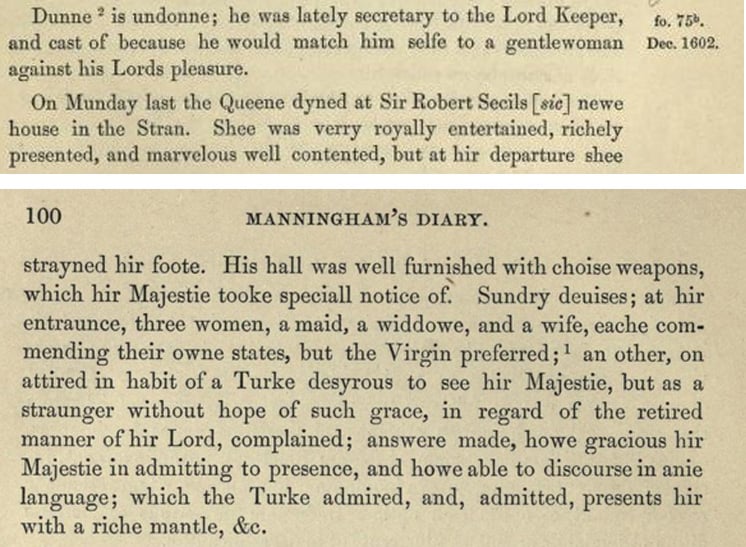
Allardyce Nicoll dates the entertainment (and the presentation of Davies’ poem) to 6 December 1602.[14] Notably, that was just short of four months before Elizabeth died. At any rate, for the scholars, Davies’ Contention becomes a basis for safely interpreting the symbolism in the portrait centering on the queen’s virginity and fame, more or less. However, making a fuss over Elizabeth’s fame and virginity was like putting more icing on an already over-iced cake. To everyone in England, and probably Scotland and Ireland, Elizabeth was the most famous living person in the world. Everyone knew she was the Virgin Queen. Anyway, the presumptive ‘connection’ of these clichés to the portrait is drawn from the ‘victory of the maid’ (a virgin) in Davies’ poem. According to Mary C. Erler:
The connection between Davies’s poem, Boissard’s engraving, and the Rainbow Portrait is further strengthened when we notice that, in the Rainbow Portrait’s headdress, the triumph of virginity over wife-and widowhood, which is the point of the poem, has been underlined by the painter’s adaptation of Boissard.[15]
To say that the maid’s victory was a ‘triumph of virginity’ (another cliché associated with Elizabeth) is something of an exaggeration. The poem is accessible on the internet. It’s nothing extraordinary, but maybe worth reading. As the Contention goes, a widow and a wife engage in a teasing debate with a maid. The point of contention is who should lead the ceremonial offering to the virgin goddess Astraea. Predictably, the two once-upon-a-time virgins eventually concede and allow the maid to win the argument and lead the offering. It might be observed that, within this symbolic contention, we have the maid (representing Elizabeth) paying homage to Astraea (also representing Elizabeth). This little dialog would have served the ceremonial bootlicking of the queen and her virgin persona that had become obligatory at such occasions. However, the virgin symbolism pertaining to Elizabeth being the very epitome of cliché at that time, what is it, we may ask, that especially connects the Contention to the Rainbow Portrait?
It gets a bit complicated. It has to do with: the lady’s costume; especially the hat; John Davies’ poem; Henry Peacham’s Minerva Britanna; Boissard’s Habitus variarum orbis genitum; and Caesar Ripa’s Inconologia. Bear with me. I will go slowly. We will sort this out.
I want to pick up here on the most penetrating (this may be taken as punning innuendo) analysis of the Rainbow Portrait that I have found, that of Daniel Fischlin. Having penetrated deeper than all of his colleagues, having clawed his way to many insightful, and above all, disturbing observations, it is Fischlin who faces the greatest challenge to explain what he found. And he makes no attempt. This inevitable failure is telegraphed in the title of his essay: ‘Political Allegory, Absolutist Ideology, and the “Rainbow Portrait” of Queen Elizabeth I’.
One is forced to ask, what ‘political allegory’ and what ‘absolutist ideology’? He says:
A number of features in the portrait combine to form a forceful, political allegory that is presented within a complex skein of allusions, not all to be read in terms of traditional iconography …the resonances of the portrait, whoever drew up its program, may not have been wholly within the interpretive traditions of Elizabethan portraiture.[16]
Okay. But, where’s the beef? What exactly were those political statements? What was the motive for making those statements in this portrait? And who was motivated to “draw up its program”? Fischlin says:
The portrait, no doubt, is a hybrid—aesthetic, religious literary, and so forth—but it is a hybrid designed in such a way as to occlude the overt political significations that would have undermined it as political representation.[17]
A “representation” of what exactly? To what purpose? How can this be squared with the assumption that Robert Cecil commissioned the portrait? We have a clear idea of the kind of ‘political representation’ Cecil would have orchestrated. Why would he (or any other loyalist associated with Elizabeth’s court) suddenly veer off in the direction of a deeply problematic ‘political’ (and erotic) message that needed to be ‘occluded’ or obscured from general view? Ignoring these questions while amplifying their importance, Fischlin continues:
The very fact that commentators have missed or ignored the political symbolism at work in the portrait indicates either that it is so obvious as not to warrant mention, or that it is so cleverly concealed as to be virtually unnoticeable. If the latter option is indeed correct, then the highly accomplished features of the painting may well serve to distract viewers from the cryptic and dissimulative artifices that are the keys to the portrait’s allegorical dimensions.[18]
Fischlin’s reasoning is on target, but there is no follow-through. He only gets far enough beyond generalities to construe an obscure message that he leaves motiveless and completely unexplained. He says:
Those dimensions include the political insofar as the portrait comments on monarchic governance in the anxious, historical contexts of a sovereign who, without direct heirs, was near the end of a reign in which some measure of political stability, however illusory, had been achieved. Though commentators have averted their eyes from the political dimensions, preferring instead to reflect on the general structure of the portrait, it seems clear that the portrait intends a political allegory, however, concealed, that comments on the dimensions of the absolute ideology it enacts….[19]
Let us say the painting is ‘enacting an occluded absolute political ideology’. So what? What is the point? Who was the intended audience for this ‘unnoticeable’ message? Like a police detective who finds a bloody crime scene, a body, and a murder weapon, but who has no intention of looking for the murderer, Fischlin just keeps pointing to the clues at the crime scene. Solve the crime? The idea didn’t occur to him. But he does quote W. J. T. Mitchell:
“We can never understand a picture unless we grasp the ways in which it shows what cannot be seen”.
And then Fischlin falsely claims:
My reading of the Rainbow portrait attempts precisely this task by way of the covert ideological structures relating to absolutism on which the portrait comments.[20]
No, Fischlin does not ‘attempt to be precise’ with respect to meaning which, I insist, cannot be separated from purpose and motive. To a degree Fischlin has ‘seen’ beyond what is overt, but he has not ‘seen’ enough. He is blinded by the conventional interpretive context. Most importantly, he has not ‘seen’ that the eyes and ears and mouths (collectively, the most important element of the portrait’s narrative) are demonstrably where they normally “cannot be seen”, that is, as I will keep saying, on the inside of a cloak! Fischlin says:
The second element of the portrait that has not received much commentary is the Queen’s cloak, with its eerie depiction of eyes and ears facing out toward the viewer.[21]
‘…toward the viewer’! That is as close as Fischlin comes to observing the most important clue in this painting. Not Fischlin, nor any of the ‘experts’ I have consulted, have commented on the entirely ‘noticeable’ fact that the cloak is a cloak of secrecy! Nothing in the painting is more pregnant with meaning than that; and I say again, amazingly, absolutely no one seems to have noticed. Fischlin says (underlines added):
John M. Archer reads the folds as “tongues” (4), the shift from Frye’s to Strong’s to Fineman’s to Archer’s interpretation of the folds indicating the difficulty critics have had attributing meaning to the folds, itself a particularly canny iconic representation of a sliding signifier. The painting clearly eroticizes Elizabeth’s body, whether or not one sees the portrait in the same way as Fineman, Frye, Archer, and Strong. The ambiguous folds, in combination with the vaguely phallic rainbow and the string of pearls looped suggestively round Elizabeth’s genital area, image an erotic potential complicit with the sovereign vitality the portrait projects. Moreover, the capacity to transfix with both an erotics of ambiguity and an ambiguous erotics fortifies the absolutist dimensions of the portrait…[22]
Fischlin wanders off into a fog of academic gobbledygook; “erotics of ambiguity” and “an ambiguous erotics”. I will point out again the general problem that Elizabethan scholars accept ambiguity as an answer, which is nonsense, historically speaking. And this ‘ambiguity’ was commissioned by Robert Cecil? In my non-academic opinion, Fischlin’s idea of “absolutist dimensions” is too ambiguous to explain anything. However, if he is correct (and I am sure he is), that the painting ‘eroticizes Elizabeth’s body’, what was the motive? What was the purpose? Did the painter sneak that in? Was he taking liberties to satisfy his need for artistic expression? Highly improbable. But, consider how far Fischlin goes with this dangerous interpretation (underlines added):
Furthermore, if the queen’s left hand, with its index finger inserted in one of the mantles folds has some sort of masturbatory significance, again if one accepts Frye’s sexualized reading of the mantle’s folds, then the painting seems to be asserting, however cunningly or ambiguously, the Queen’s sexual aloofness, itself a metonymy for her political uniqueness. The portrait may slyly hint, however shocking such a suggestion may be, at the nature of the unmarried queen’s autonomous sexual practices while also affirming the queen’s political authority by virtue of the gaze she maintains and the intelligence she receives while touching herself.[23]
Let us say that this obscure tangle of sexual and political meaning is meaningful. I ask again: Motive? Let us remember the Coronation Portrait (figure 5):
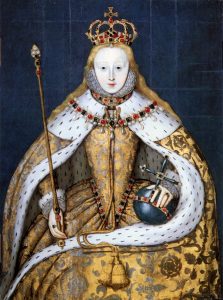
It is easy to overlook that, in the history of Europe, England’s Virgin Queen was something extraordinary. And by way of the generally accepted conceit, she was the Faerie Queene, the incarnation of Astraea and Diana, a goddess, a supernatural being. For England, for more than four decades, she was the center of the political universe, real and make-believe. Any symbolic or personal message about the queen was ‘political’ and much of it loaded with romantic-religious-mystification. I think it is reasonable to say that the messaging Fischlin is inferring is fundamentally subversive. I ask again: who would be behind such messaging? Unless I have misread Fischlin, he never asks these questions. No one does. But he is very warm. He is only centimeters away from the meaning he cannot see. He quotes Frye:
“[Elizabeth’s] body as the center of a Ptolemaic universe while wrapping her in a mantle whose open mouths, ears, and eyes form a disquieting suggestion of vaginal openings combined with a sense of governmental surveillance”[24]
Critiquing, Fischlin says:
Frye does not develop her “suggestion of vaginal openings” nor their relationship with governmental surveillance, if any at all.[25]
But, neither does Fischlin “develop” his ‘suggestions’ into anything probative or substantial. He does not take the next step to connect the alleged messaging to a practical purpose and motive. He says:
Reading the folds in the mantle as mouths—themselves a visual metonymy [rhetoric] for the vagina—is extremely problematic with regard to the apparent logic of the portrait’s representation of the “queen’s chaste body.”[26]
Indeed, ‘extremely problematic’! And? Imagine your doctor saying, ‘You have a deadly infection that needs to be treated immediately with antibiotics. Have a nice day!’ Somewhat earlier Fischlin says:
…if the erotics of the portrait entail a contemporary reading of the mantle’s folds as mouths or vaginas, the political dimension of the queen’s erotic allure cannot be ignored.[27]
But, in terms of purpose and motive, Fischlin does ignore them. He goes much further than any of his colleagues in paying attention to them, only to walk away from the problem. Fischlin leaves us adrift with his idea of ‘Political Allegory’ and ‘Absolutist Ideology’, whatever that means. Let’s see if we can find our way to shore.
An Oxymoronic Hat
Where did the idea for this hat come from? Dame Frances A. Yates tracked it down (figure 6):
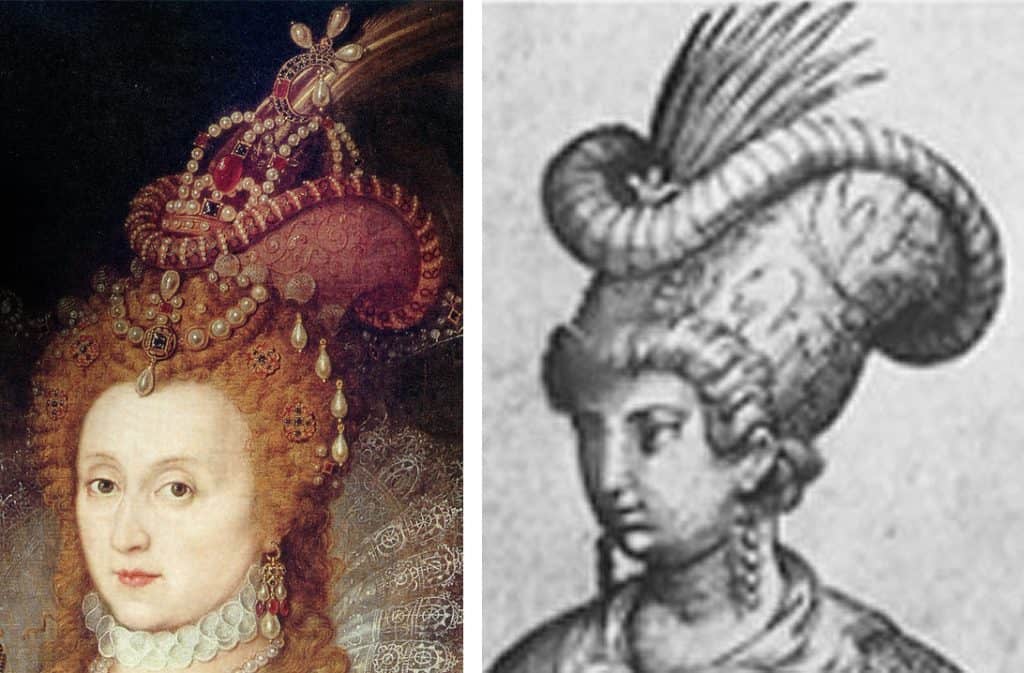
Above, on the left, is the hat from the Rainbow Portrait. On the right (reversed from the original) is the be-hatted head of the figure called ‘Sponsa Thessalonicensis’ from J. J. Boissard’s Habitus variarum orbis gentium (‘Styles of the Various Peoples of the World’), published in 1581. Here’s the full plate from Boissard (figure 7):
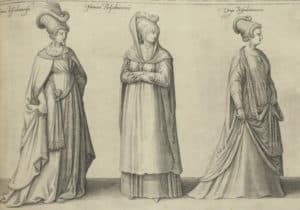
If you want to examine this plate, or the other plates, you can access Jean Jocques Boissard’s book for free via the internet.[28] Thessalonicensis refers to the Greek city of Thessalonica, aka, Thessaloniki, Salonica, or Salonika. It is the second-largest city in Greece. But, here’s the problem: Sponsa Thessalonicensis means ‘Bride of Thessalonica’. The lady’s hat is a bridal headdress. The point I am emphasizing is that, to be a bride bears the non-negotiable implication of giving up one’s virginity! How is a bridal headdress appropriate symbolic attire for a perpetual Virgin Queen?
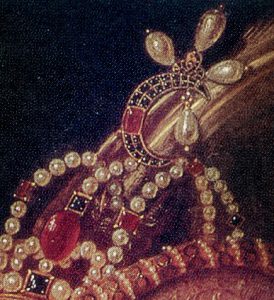
Examining the bridal hat, with its integral crown, we find multiple symbols of virginity (feminine purity), including white pearls and a crescent moon (one of the major symbols for the chaste virgin goddess Diana) (figure 8):
How do the scholars deal with this oxymoronic headdress? Mary C. Erler says:
Finally, she [Yates] discovered the similarity between the portrait’s headdress and that of a figure labeled “sponsa Thessalonicensis” in J. J. Boissard’s Habitus variarum orbis gentium (Cologne, 1581): consequently she suggested that both this painting and two others might represent the sitter in masque attire which had been adapted from a book of costumes.[29]
Where this is headed is Yates’s idea, as previously mentioned, that the portrait represents a ‘composite’ of costumes. Yates’ intent is, as I understand her, to have it both ways, to take the symbolism seriously in some parts and not take it seriously in others. As for the hat, Yates seems to take the latter course. The problematic hat is just decoration. Again I am repeating myself. It seems to me that, in a portrait that is screaming ‘Look at my symbolism!’ that makes no sense. But let’s see where this goes. Continuing her argument for more or less meaningless symbolism, Erler says:
Each plate in Boissard’s book shows three figures of equal size, arranged side by side, who illustrate the characteristic dress of a single city or country. Thus Plate 38 (fig. 2) presents three female figures captioned “Sponsa Thessalonicensis,” “Foemina Thessalonicensis,” and “Virgo Thessalonicensis.” The plate, that is, provides the typical costume of a wife, a woman, and a maid of Thessalonica, or Salonika. Yates, in demonstrating the Sponsa Thessalonicensis’s headdress was the source of Elizabeth’s in the Rainbow Portrait, reprinted only the figure on the left side of the plate. It seems likely, however, that it is the plate’s presentation of three female figures grouped together which caught the eye of the Cecil entertainment’s designer—three figures who correspond closely with the three women of Davies poem performed for that occasion. [30]
Thus taken, the portrait’s objective was not symbolism, but coming up with a nice costume, as a kind of potpourri of costumes that may have been worn at the event by various ladies or maidens, possibly including the queen. In that case, looking for specific symbolism in the portrait, or a symbolic theme, is pointless. One shouldn’t take it too seriously. But, that is not a unanimously held opinion.
Taking the symbolism seriously, I pose what I believe is a simple, and I think, critical question that no one is asking. Why isn’t Elizabeth wearing the hat of the virgin, Virgo Thessalonicensis? That would have been taken from figure 9:
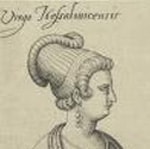
Sorry that the image is a bit blurry. The two hats are similar but it is unmistakable that the one Elizabeth is wearing is the bridal version. I ask the question again: why is a virgin wearing a bride’s hat? Ignoring my question, Erler continues:
Yates, in demonstrating the Sponsa Thessalonicensis’s headdress was the source of Elizabeth’s in the Rainbow Portrait, reprinted only the figure on the left side of the plate. It seems likely, however, that it is the plates’ presentation of three female figures grouped together which caught the eye of the Cecil entertainment’s designer—three figures who correspond closely with the three women of Davies’ poem performed for that occasion.[31]
Okay. Davies’ Contention has a virgin, a wife, and widow. Boissard’s engraving has a virgin, a bride, and a woman, presumably a wife. For Davies’ purposes, a bride would have been out of place. So the widow is a reasonable replacement. Could the three women in Davies’ poem represent the three women in the engraving more or less? They could, but there are many more engravings, each with three figures, many with similarities, and frankly, upon close observation, I do not see how Erler justifies her claim that these “three figures…closely correspond with the three women of Davies’ poem”. There are too many variables and to many other plates with similarities. To justify such a statement I think she would need to closely examine and consider the other figures in the other engravings. And I hope it is not lost on the reader that what Erler is proposing is about 99 percent speculation. However, the point is that, having resorted to mishmash symbolism, Erler can ignore the oxymoron of a virgin queen wearing a bridal headdress. She says:
To the engraving’s headdress he has added a crown and a crescent jewel, the former symbolic of Elizabeth’s rule (and perhaps of Davies’s virgin victory), the latter symbolic of virginity.
I have no problem with the symbols of virginity and the crown on the head of a ‘virgin queen’. I have a problem with the fact that the hat is a bridal headdress. If we are going to construe the symbolism to be important, I think we ought to be consistent. Seeking to tighten the connection of Davies’ poem to the Boissard engraving, Erler says:
Davies’s “Contention” refers to the regal emblem thus:
…on all true virgins at their birth
Nature hath set a crown of excellence,
That all the wives and widows of the earth
Should geve them place, and doe them reverence [Lines 21-24) [32]
Indeed. A crown. On the head of a queen! What a rare idea! There is, I think, some degree of inevitability in that. But, I am not insisting there is no connection between the portrait and Davies’ poem. There may well have been. As a means of ensuring that everyone was comfortable with that Trojan Horse of a portrait, there had to be a cover story. I suspect that Oxford and Davies collaborated. What bothers me is the loosy-goosy handling of symbolism and the facts by ‘professional scholars’. So, what about the bridal hat? Not content to simply cloud the symbolic waters, Erler goes all in to muddy them, throwing in other examples from Boissard’s book:
In addition to the plate, three others in Boissard’s Habitus present a figure labeled “Nova Nupta,” or bride. Plates 5 and 6 show a Venetian bride; the former of these resembles the Rainbow Portrait slightly in its use of pearl jewelry and its gauzy, figure-enclosing veil….The décolletage of all three Roman figures, and the transparent enveloping veil which “Nova Nupta” and “Foemina” wear, are similarly found in the [Rainbow] portrait. … if the Roman bride is viewed in reverse, the similarity of posture becomes more striking; here the position of the lower hand, the gathering the drapery, is identical with that of the Rainbow Portrait.[33]
Here’s the figure Erler is referring to, and again the Rainbow Portrait for comparison (figure 10):
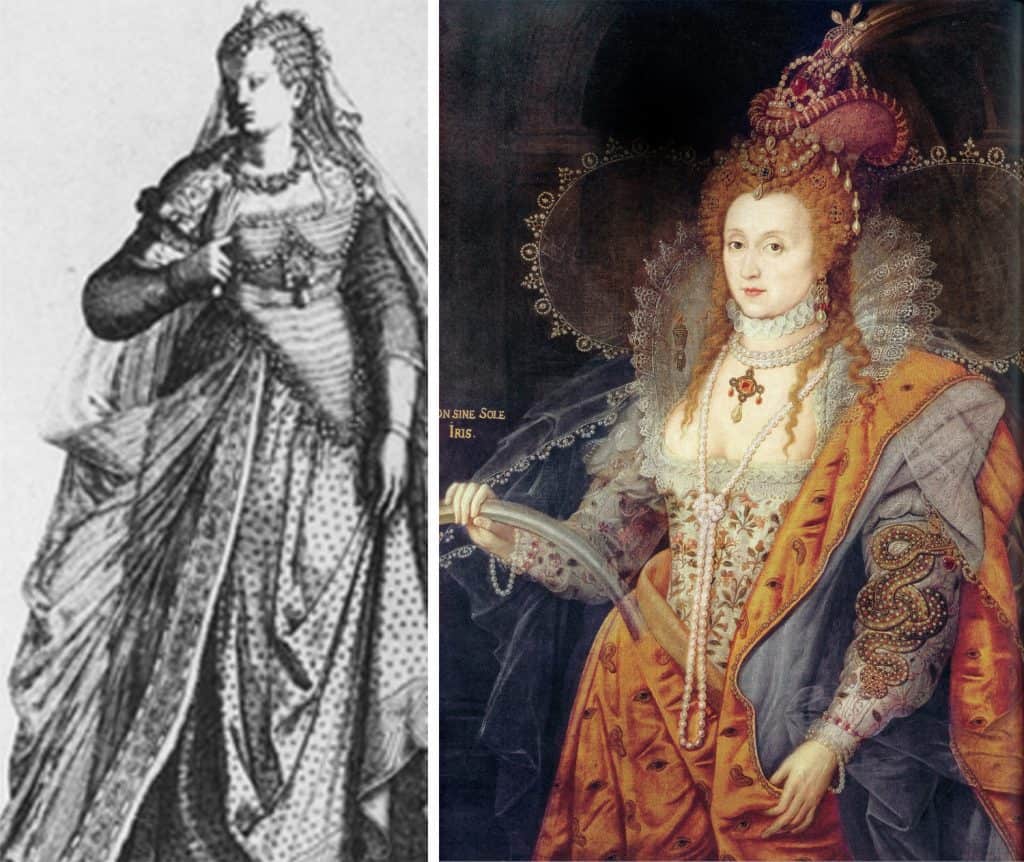
I have reversed the figure on the left as Erler proposed.
Here’s the full plate (figure 11):
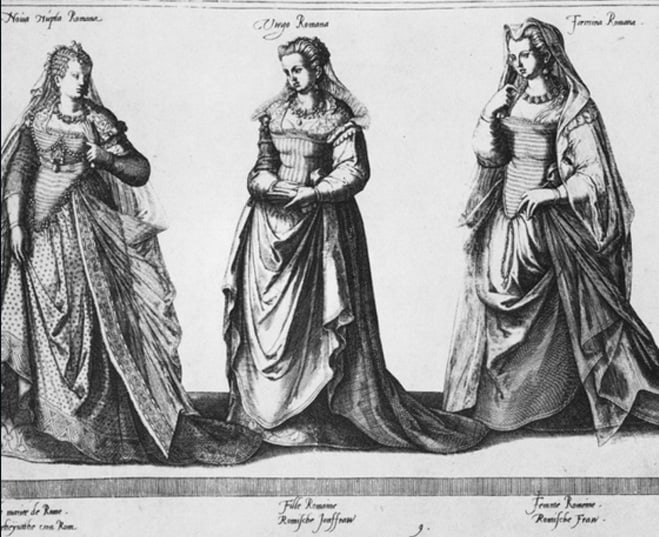
Erler says:
Yates suggested that “the clue to [the Rainbow Portrait] may be that it records Elizabeth’s presence at some masque in which allegories in her honour were presented by various personages but which are now summed up in a composite portrait of herself.” Davies’ poem, combined with Boissard’s Thessalonian and Roman designs, provide the particulars which flesh out this hypothesis.[34]
Similarities and composite, hybrid, symbolism? Pick anything you want from the smorgasboard of Boissard’s book and match it up with Davies cliché-rich poem and there is no need, and no point, in debating the “particulars”, as Erler calls them. It is the very essence of academic discussion. Swirling ambiguities. Erler sweeps away all the problems of symbolic meaning. We could go on about the hat, but let’s move on.
Eyes and Ears, and Mouths?
Again, the most obvious and difficult thing to explain about the portrait are the eye and ears, and most especially the mouths. Everyone agrees there are eyes and ears. But are there mouths? Let’s start there. (figure 12)
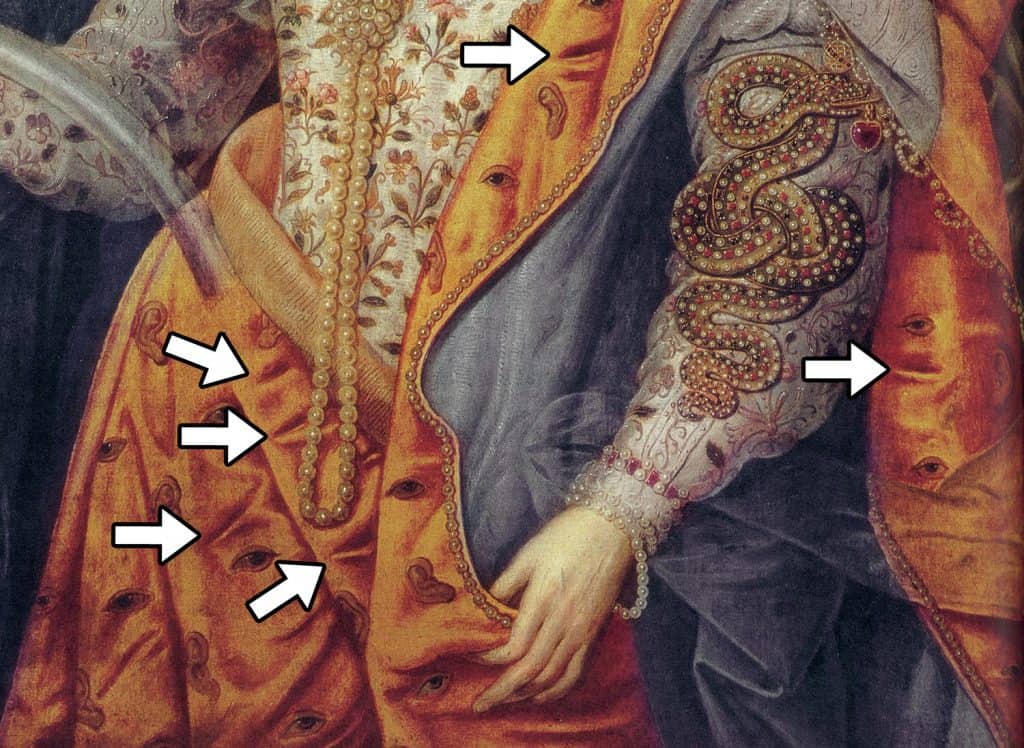
Are those folds mouths, or are they just folds? As I said, the scholars are confidently divided. Based on my informal survey, opinion divides up as follows:
Pro mouth: 1) Frances Yates (undecided); 2) René Graziani; 3) Christopher Pye; 4) Susan Doran; 5) Raymond L. Lee; 6) Alistair Fraser; 7) Valerie Traub; 8) Daniel Fischlin
Contra mouth: 1) Mary C. Erler; 2) Roy Strong; 3) Michael Neill; 4) Frederick Kiefer; 5) Anna Whitelock;
By the way, Wikipedia cites only Strong and doesn’t mention mouths.[35] I don’t claim to have polled everyone. I hope I have them sorted correctly. If not, I apologize. This should suffice for now. Anyway, there is no consensus among the experts. Roy Strong is perhaps the best known clearly contra-mouth expert. I quote him again (underline added):
A detailed examination of this garment shows no signs of the mouths read into it by scholars [a reference mainly to Frances Yates] so that it could signify the Queen’s fame ‘flying rapidly through the world, spoken of by many mouths, seen and heard by many eyes and ears’. [36]
Strong’s claim is clear and ex cathedra, “A detailed examination”. By whom? How “detailed”? By what method? Since Strong offers no information, I assume the “detailed examination” was conducted by Strong himself by looking closely at the portrait. His principal argument is that the eyes and ears symbolize Fame, or should. He reasons that mouths would reinforce that interpretation, but he ran into trouble when he went to match up the eyes, ears, and mouths with the iconological precedents. To be consistent with the iconographic precedents, he rules out mouths which allowed him to not see them. Trying to assist, Frederick Kiefer says:
In the portrait the queen herself has indeed come to embody Fame. Ironically, Roy Strong himself, whose work is cited by everyone who discusses the Rainbow Portrait, acknowledged, almost twenty-five years before he published Gloriana, the connection with Fame, though he mistakenly thought that the presence of mouths would clinch the identification: “The cloak which encircles Elizabeth is covered with eyes and ears and is probably intended for Fame (although strictly speaking there should also be mouths).” [37]
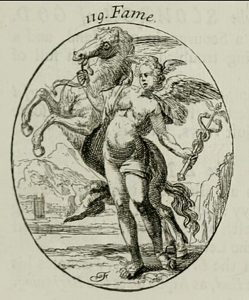
These two ‘professional scholars’, Strong and Kiefer, are both grossly mistaken. The iconographic representations of Fame do not, as a rule, exhibit mouths or eyes or ears! Here is the figure for Fame from the 1709 English translation of Cesare Ripa’s Iconologia which is essentially unchanged from the earlier editions of Ripa’s book (figure 13):
No eyes, no ears, no mouths. In fact, Fame is typically depicted with the ‘wings of Mercury’ (as we see here) and often with a trumpet. Here’s the description that goes with Ripa’s Fame figure (figure 14):

We see, not surprisingly, that speech and voice are associated with Fame while they are not part of the graphic symbolism in the available precedents. Inexplicably, Kiefer says:
In fact, Renaissance Fame is never decorated with mouths, only eyes, ears, and sometimes, tongues, as hundreds of prints and other representations demonstrate.[38]
Where is Kiefer getting his information? Not from Ripa’s Fame. Fame is not depicted with eyes, ears, or tongues. Kiefer is similarly contradicted by the Encyclopedia of Comparative Iconography: Themes Depicted in Works of Art.[39] How did Kiefer and Strong manage to be so completely wrong on something so completely obvious? Simple. While seeming to talk about Fame, they switch to a different figure. Strong says:
The symbolism of the cloak in fact presents no problems. Henry Peacham has just such a garment in one of the emblems in his Minerva Britanna (1612); it is worn by Ragione de Stato and is in fact lifted directly from Ripa’s Iconologia.
Be serv’d with eies, and listening ears of those,
Who can from all partes give intelligence
To gall his foe, or timely to prevent
At home his malice, and intendiment.[40]
Now Strong is suddenly talking about a figure called Reasons of State. Here is that figure from Peacham’s Minerva Britanna (figure 15):
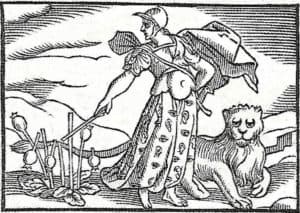
‘174 Ragione di stato wearing a robe covered with eyes and ears’
Eyes and ears, and no mouths, on the wrong figure! So, Strong has the wrong figure and, please note, fails to observe that these eyes and ears are on the outside of the garment. What does Peacham’s figure of Ragione di stato have to do with the Rainbow Portrait? Nothing! Minerva Britanna wasn’t published until 1612, ten or twelve years after the painting was painted. But, it will be instructive to stay for a moment with the unrelated figure Ragione de stato and Ripa’s Iconologia from which Peacham almost certainly borrowed in 1612. According to Wikipedia:
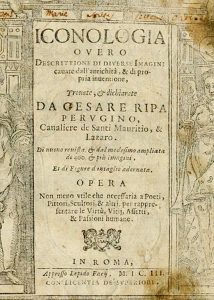
The first edition of his Iconologia was published without illustrations in 1593 …A second edition was published in Rome in 1603 this time with 684 concepts and 151 woodcuts …The book was extremely influential in the 17th and 18th centuries and was quoted extensively in various art forms. [41]
Here is an image of the cover of Iconologia bearing the 1603 date (figure 16):
https://archive.org/details/iconologiaouerod00ripa/page/n3
Below is a side-by-side comparison of Ragione di Stato (Reason of State) in the Peacham and Ripa versions (figure 17):
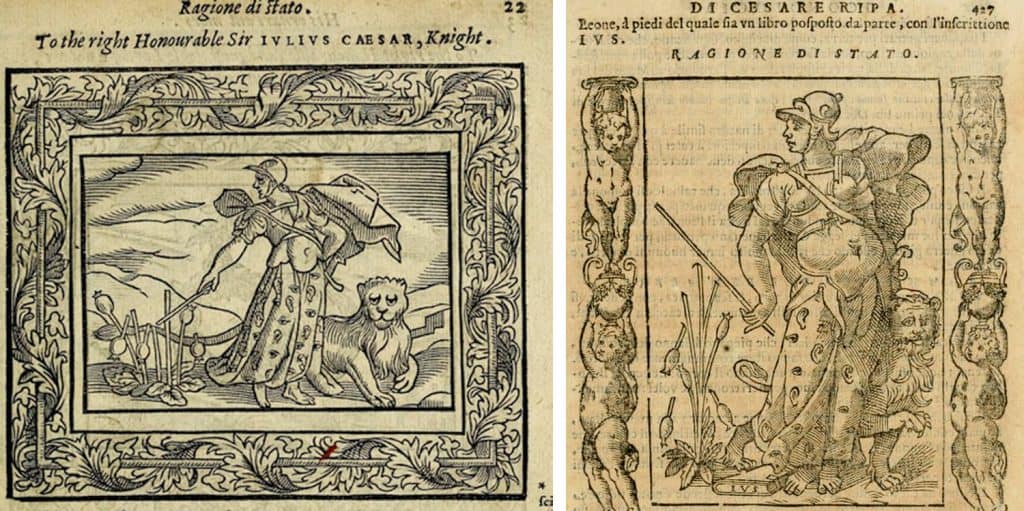
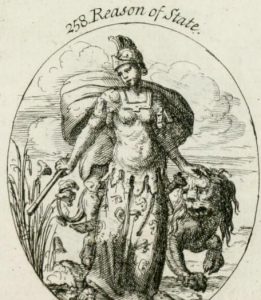
We see that Peacham’s version was faithful to the Ripa version. To be safe, let’s go ahead and take a look at Ragione di Stato (Reason of State) from the 1709 English version (figure 18):[42]
The symbolic elements are essentially the same in all three versions with eyes and ears on the outer surface of the skirt. Now, having mysteriously slipped Ragione di stato in place of Fame, Strong also neglects to mention that, in Ripa’s Iconologia, there are three other figures with similar eye and ear symbolism. They are: Gelosia (Jealousy); Curiosita (Curiosity); and Spia (the Spy). For the figures of Curiosita and Spia, Ripa (1603) provides only descriptions and no drawings. Here is Gelosia from 1603 version (left) and the 1709 version (right) (figure 19):
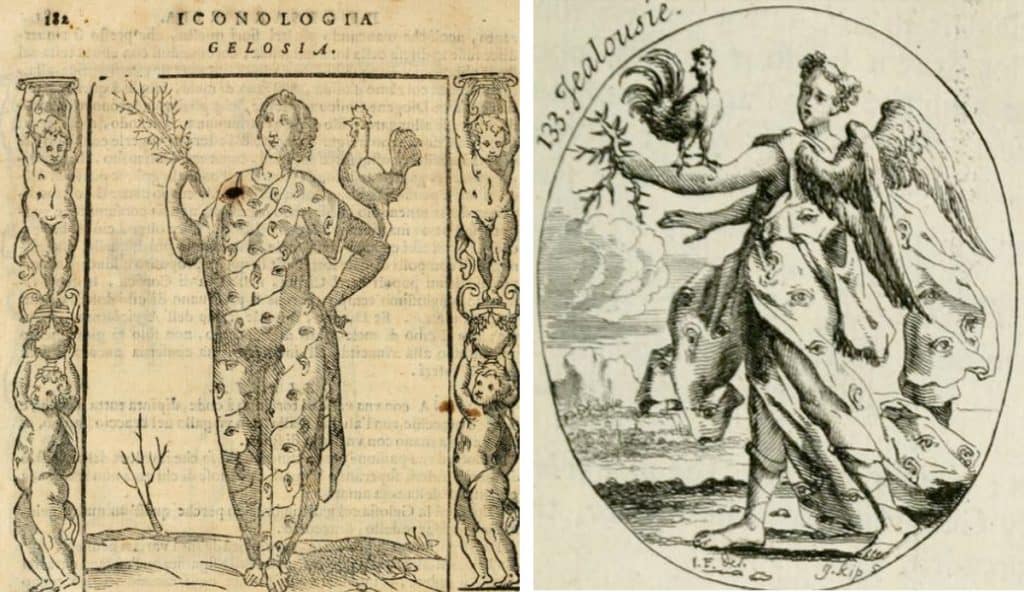
Eyes and ears are normal features for this figure. Below is the 1709 English version of Curiosity (figure 20):[43]
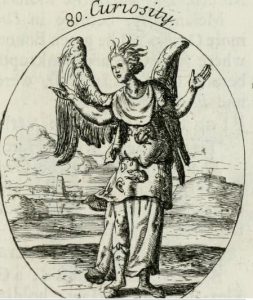
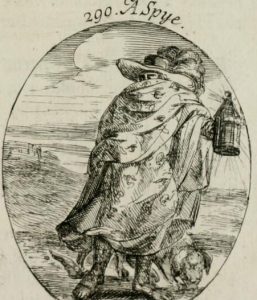
Again, eyes and ears. To the right is the figure Spia (the Spy) from the 1709 version (figure 21):
Again, eyes and ears and, though hard to make out, tongues. Since it is difficult to see the detail in these printed figures, let’s look at the accompanying descriptions for all four figures. The following descriptions are from the 1709 English version (figure 22):
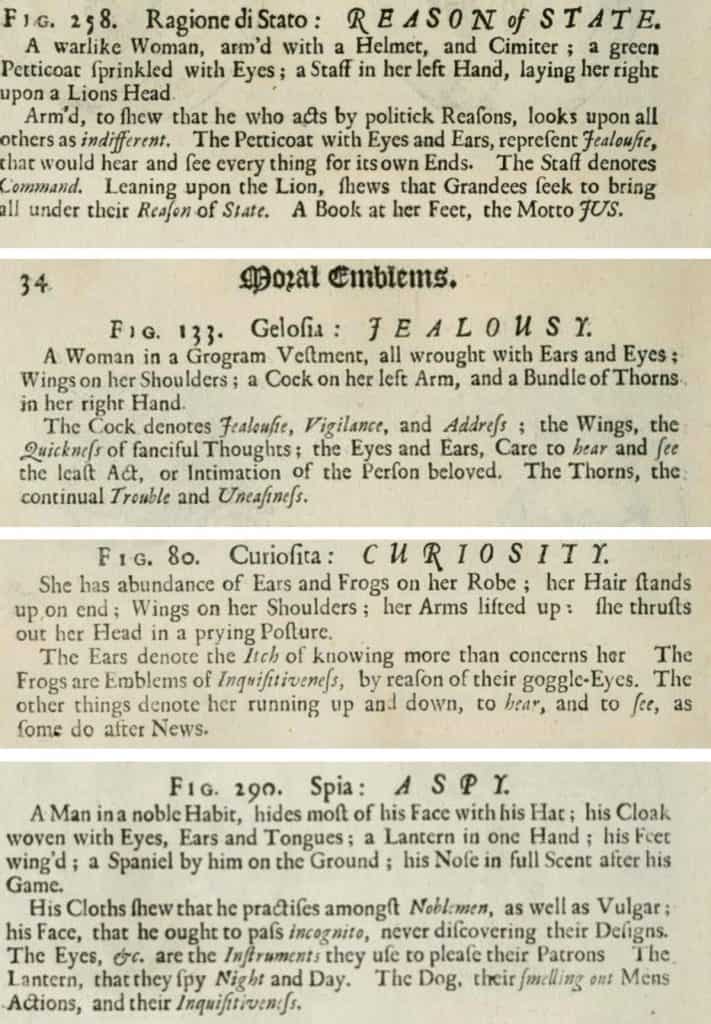
Here is my summary of the symbolic features from each of these figures:
- The State: Eyes and ears represent Jealousie that would hear and see everything for its own ends.
- Jealousy: Eyes and ears care to hear and see the least act or limitation of the person beloved.
- Curiosity (excess curiosity): Ears denote the itch of knowing more than concerns her.
- A Spy: The eyes, ears, and tongues are instruments they use to please their employer.
Perhaps we can agree that tongues and mouths serve the same symbolic purpose. In that case, the figure that comes closest to the symbolism in the Rainbow Portrait is Spia, the Spy, and that, I think most people will agree, is not a quality an ostensibly benign ruler would advertise. But then again, none of these figures represents desirable qualities in a ruler from the perspective of the subject or citizen; and though none of these scholars is willing to call a spade a spade, this is the central problem in trying to explain the eyes, ears, and mouths in the liner of the cloak in the Rainbow Portrait. They just don’t seem benign.
Therefore, intuitively, Fame seems like a good explanation. The problem is that you have to ignore the iconographic precedents. So, to recap. The five iconographic figures we’ve considered that have eyes and ears are not benign (with the possible exception of Curiosity). Fame, which would be benign, has no eyes or ears and no mouths. It’s a conundrum. And the problem remains, as I keep pointing out—and as none of these scholars do—that the eyes and ears and mouths in the Rainbow Portrait are on the inside of the garment. Trust me, we will come back to that again. Let’s dig deeper into the mouths.
Mouths or Folds?
Let us go back to Roy Strong’s strong assertion that “detailed examination of this garment shows no signs of the mouths”. How was that determination made? There’s no indication that he consulted anyone. Who would count as an authority? A portrait artist? I don’t think so. Someone experienced in period costume design? Perhaps. But, let’s approach this analytically. The thing about the mouths, compared to the eyes and ears, is that they are ambiguous. The eyes and ears are well defined. The mouths are merely suggested. Why? Below (on the top row) are some close-ups of the Rainbow Portrait. In the row underneath, for comparison, are close-ups of mouths painted by Rembrandt (figure 23):
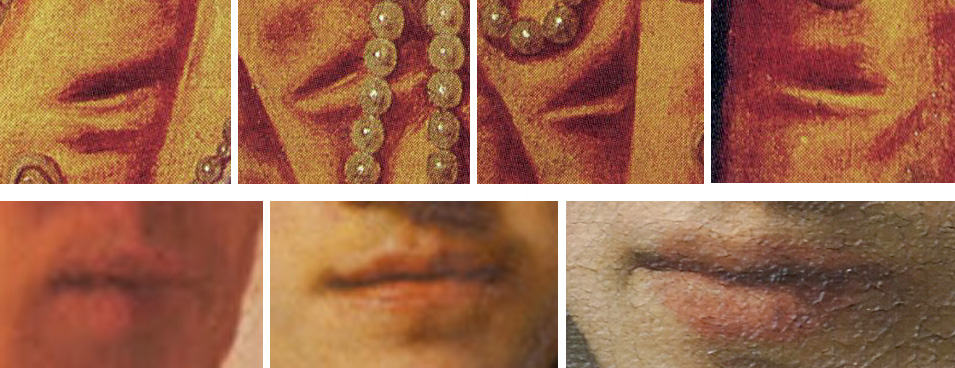
Pardon if they are a bit dark or blurry. The point is: if the painter of the Rainbow Portrait had wanted mouths to be unambiguous, he could have made them unambiguous. So, by simple visual inspection, we cannot determine that the mouth-like folds are intended to be mouths. However, nor can we determine that they are not meant to suggest mouths, as claimed by Strong. Nor can we rule either way on the suggestion by Traub and Fischlin, et al., that the folds represent vaginas. Are there any experts who can help sort this out? I think there are. But we have to turn the question around. The question is not whether the mouth-like folds are mouths, but whether the mouth-like folds are folds. If they are not folds, they are, by default, almost certainly mouths (and possibly vaginas). But, noting that the preponderance of scholarly opinion seems to fall on the side of the folds being mouths, perhaps that is sufficient for our purpose here.
There is some additional evidence that may help advance this discussion, and which, I think, confirms that Marcus Gheeraerts was, in fact, the painter of the Rainbow Portrait. The portrait below was painted by Gheeraerts (so indicated by his signature) and is dated to 1611, roughly ten years after the Rainbow Portrait. I place it side by side with Rainbow Portrait (figure 24):
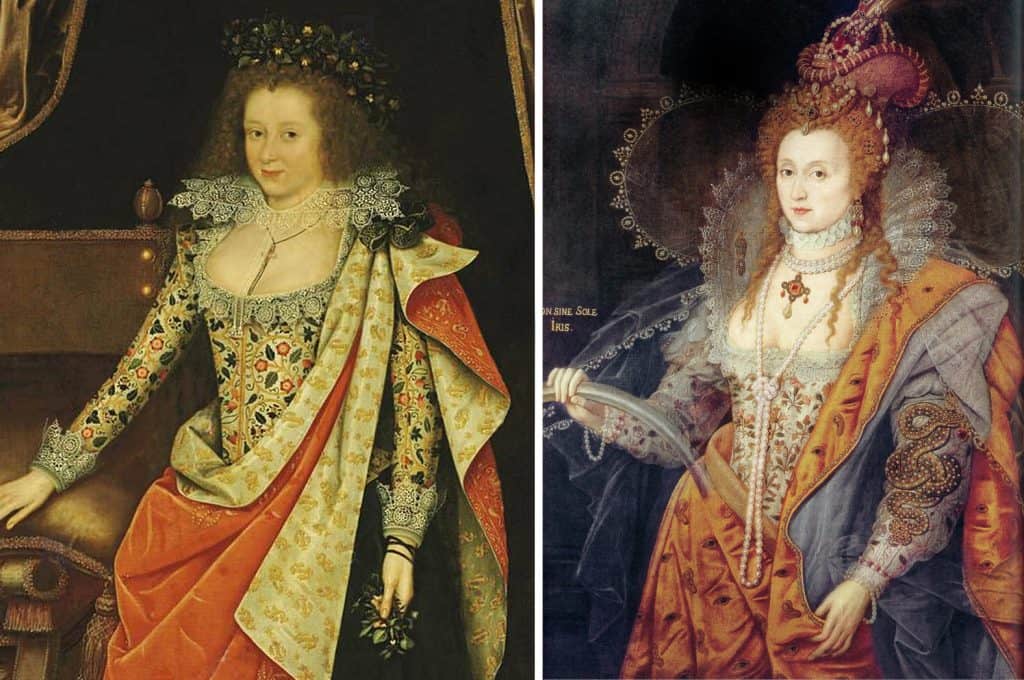
I must note that, in the Hertford, the orange-gold fabric is on the outside of the garment (which looks like a tablecloth). The grey on the reverse side is effectively on the inside. Based on the positioning of the folded fabric around the lady’s right hip, the floral embroidery on the bodice, the fine lace along the edge of the bosom and in the collar, the treatment of the bosom, the positioning of the body and head and the facial expression, I think we might agree that the portrait of Lady Hertford was intended to resemble the Rainbow Portrait. I think that those who have some familiarity with painting technique will also agree that these two portraits are very likely by the same artist. Not seen or intimated on the draped fabric of the Hertford Portrait is any suggestion of eyes, ears, or mouths on the fabric. There are a couple of curious little creases. Let’s look more closely (figure 25):
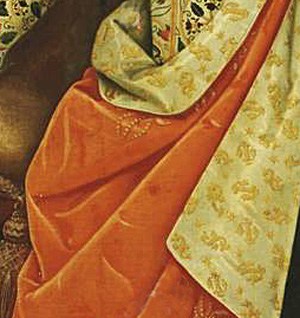
I count three little creases on the Hertford. I do not believe that, even if led in that direction, anyone viewing this portrait would suspect that those little creases are mouths. They are not ambiguous. In our comparison of these two portraits we see just how distinctly mouth-like the folds in the Rainbow Portrait are. I think we have multiple substantial reasons to question Roy Strong’s “detailed examination”. Perhaps someone would like to attempt an edit at Wikipedia and cite some other sources.
Failed Explanations for the Eyes and Ears and Mouths
Roy Strong, evidently in desperation, reached forward through time to Peacham’s Minerva Britanna of 1612 to explain the eyes and ears that appeared in 1600-1602 in the Rainbow Portrait. And, without knowing it, he reached as far backward through time again. Strong says:
Peacham is using the ears and eyes in the same way John Davies refers to the Queen’s use of her servants (of whom Cecil was chief) in his first entertainment in 1600: ‘many things she sees and hears through them, but the Judgment and Election are her own’.[44]
To what is Strong referring? He is referring to another little script written by John Davies, this one called, A conference between a gentle-man usher and a post (messenger) before the Queen at Mr. Secretary’s house. Therein we find the bit of dialogue Strong refers to, and from which I will quote again momentarily. The ‘Post’ (messenger) bears letters from the emperor of China. Protocol requires that they be delivered to the queen’s secretary. The usher advises that the secretary is not available and that the messenger can deliver the messages directly to the queen herself. The messenger is startled by the advice and is intent on following protocol. The usher insists. He says:
Usher: I know not what you think, but I am sure the world thinks she [the queen] doth herself best service when all is done, for all her morose servants; though I confess (for honour’s sake) all great princes must have attendants for their business.
What the usher means is that the queen is a practical person and prefers that things ‘get done’ without excessive deference to protocol, even if there are many servants attending her. To which the messenger replies:
Messenger: Is it so? Why, then, I pray thee, tell me what use doth she make of her servants.
The messenger’s point is: Why then have all those servants? And the usher replies:
Usher: Many things she sees and hears through them, but the judgement and election is her own.
It seems to me that the usher’s reply is incongruous, but, for our purpose here, I don’t think that’s important. Let’s follow along a bit further:
Messenger: If, then, the use of their service is so small, how come it that the reward of their service is so great?
Usher: Oh, therein she respecteth her own greatness and goodness, which must needs be such as it is, though I find no object that is proportionable: as, for example, the sun doth cast his beams upon dark and gross bodies that are not alike capable of his light, as well as upon clear and transparent bodies which do more multiply his beams. Or if thou dost not understand this demonstration, I will give thee one that is more familiar. She doth in this resemble some gentle mistress of children, who, when they guide the hands of their scholars with their own hands, and thereby to make them write fair letters, do yet to encourage them and give them as much praise as if themselves had done it without direction.
In other words, the queen is patient and magnanimous with her servants and subjects. Now, according to Strong (and he’s not alone), in the line below, which Strong made reference to, is what is symbolized in the eyes and ears, and possibly the mouths, on the liner of the cloak in the Rainbow Portrait:
Usher: Many things she sees and hears through them, but the judgement and election is her own.
And why not? Well, let’s double check the facts. According to Strong, this little dialogue, written by Davies, was presented for the queen’s pleasure in 1600. Edmund Chambers, and a number of other scholars, slightly disagree, dating it to 1602. No big deal. But, actually, there is a big deal here. According to John Nichols’ transcriptions from the royal archives (1823), the date of the presentation of A Conference was 1591.[45] He’s very clear. Here’s a little snippet from Nichols’ book (annotated circle is on the original this was snipped from) (figure 26):

The entry that follows the one above is without date, but says:
On the second of August Sir Robert Cecil was sworn of the Privy Council at Nonsuch.
The date of Robert Cecil’s appointment to the Privy Council was 1593. Sequentially at least, the two records fit. And we have a corroborating account from Charles Knight from 1893:
Progresses of queen Elizabeth No. XI.-1587-1591. “In 1591…A conference between a gentleman-usher and a post…written by John Davies”. [46]
Knight provides no source for his information though it appears to be taken from official records. Notably, overruling Nichols and Knight, the esteemed Edmund Chambers dates A Conference to 1602. He reasons:
Nichols, Elis. iii. 77, prints from Harl. MS. 286, f.248, ‘A conference between a Gent. Huisher and a Poet, before the Queen, at Mr. Secretaryes House. By John Davies.’ He assigns it to 1591, but Cecil was not then Secretary, and it probably belongs to 1602. [47]
Mary C. Erler makes the same case:
Davies wrote another dialogue for presentation before Elizabeth, this one prose. …Since it is undated, Nichols place the work among his documents for 1591, thus assigning it to Cecil’s entertainment of the queen at Theobalds from May 10 to May 20 in that year. R. W. Bond points out, however, that Robert Cecil did not become Secretary until 1596, and both he and E. K. Chambers assign the work to Cecil’s entertainment of December 6, 1602.[48]
One will be very careful in overruling Edmund Chambers, but he is wrong in this case, and so are Bond and Erler. First of all, there is no factual reason to suppose that Nichols, lacking a date, arbitrarily assigned Davies’ Conference to the location of Theobalds. But, much more importantly, William Cecil was, in fact, Secretary of State in 1591. Francis Walsingham, Secretary of State, died in 1590. William Cecil temporarily added those duties to his own and served as ‘acting Secretary of State’ from 5 July 1590 – July 1596.[49] Thus, during that time period William Cecil was concurrently Lord High Treasurer and Secretary of State. It stands to reason that a messenger would seek to deliver letters to the ‘Secretary’ and not the ‘Lord High Treasurer’. Following standard protocol he asked for the ‘Secretary’. Following the errors of Chambers and Bond and Erler, evidently adding another, Martin Wiggins and Catherine Teresa Richardson also date A Conference to 1602. They say:
The case for identifying the dialog as part of the 1602 Cecil House entertainment depends on the hypothesis that Manningham’s account misreports the origin of the post. [50]
I have scoured Manningham’s Diary and cannot find any mention of Davies’ ‘dialog’ or ‘Conference’ therein. In the versions reported by Nichol and Knight, the letters are from ‘the emperor of China’. I’ve not found any version with a different ‘origin’. To be fair, the accuracy of Nichols’ transcriptions has been challenged on numerous counts. Another reason put forward to doubt Nichols in this case is that, in 1591, Davies was not yet sufficiently experienced and recognized as a poet to have served in that capacity for such an occasion. This is sheer uninformed speculation. Davies was born in 1569. He would have been twenty-two years old in 1591. John Milton was twenty-years old when he wrote his ‘Epitaph on Shakespeare’ that was included in the Second Shakespeare Folio.[51] The following is from the current Wikipedia article on John Davies:
He was educated at Winchester College for four years, a period in which he showed much interest in literature. He studied there until the age of sixteen and went to further his education at the Queen’s College, Oxford, where he stayed for a mere eighteen months, with most historians questioning whether he received a degree. Davies spent some time at New Inn after his departure from Oxford, and it was at this point that he decided to pursue a career in law. In 1588 he enrolled in the Middle Temple., where he did well academically, although suffering constant reprimands for his behaviour.[52]
The evidence indicates that Davies was present in London in 1591. A Conference is not regarded as a good example of Davies’ talent as a poet (to which I add my humble concurrence) and fits, qualitatively, with his early work. So, while A Conference can be construed to fit the portrait (along with countless other poems and dialogues), the documentary evidence (which is not contradicted by any factual evidence), places A Conference firmly in 1591, ten years earlier.
I apologize that this has gotten to be a bit complex; however (and this is important), as convenient as it might be as an explanation for the eyes and ears and mouths on the cloak liner, John Davies’ Conference turns out to be quite implausible. So, where are we? What else have the scholars come up with to explain those discomfiting eyes and ears and mouths? Christa Wilson puts it so:
…the cloak’s eyes and ears provide more ambiguous and inventive means of conveying Elizabeth’s unearthly insight and power. Signifying that Elizabeth sees and hears all throughout her realm …[53]
Now, think about that. It’s not that it’s absolutely implausible; it just highly improbable, in my opinion, that someone clever enough to devise this portrait would go to all that trouble to convey the message that Elizabeth was a snooping all-seeing all-hearing demigod. Were there no limits to what the average Englishman was expected to believe and tolerate? It’s not as though Wilson is completely blind to the problem. She continues:
Furthermore, by instilling a “disquieting suggestion of …governmental surveillance,” they likewise convey Elizabeth’s ability to detect and expunge both external and internal threats to her power, thus placing her above and beyond the realm of vulnerability to which the even the greatest of mere earthly princes would otherwise be subject (Frye 103).[54]
I think that, at the time, among the people of England, there was a kind of understanding that the queen’s ‘virgin queen/faerie queen’, persona was more a political expediency than reality. To put it another way, it’s like grown-ups today, and many children, treating Santa Claus as a real person while being pretty sure he isn’t. I don’t think that Elizabethan Englishmen, and English women, were stupid. I think Robert Cecil understood that there were limits to what the persona cult would tolerate. Placing Elizabeth above ‘earthly princes’, advertising her as a demigod who was ‘beyond the realm of vulnerability’ would, in my opinion, have gone too far. I think there are limits to what Elizabethans were willing to believe. Among professional Elizabethan scholars I see no limits. I am half jesting.
The Hidden Meaning of the Rainbow Portrait
For the Rainbow Portrait there are three primary points of contention: the colorless rainbow (and inscription); the eye, ears, and mouths; and the hat. What does the rainbow (and the inscription or ‘motto’) mean; why is the rainbow colorless; and why is it shaped like a tube? There are several different scholarly explanations for the missing color. The first is that the original pigment has faded. As a number of scholars have conceded, this is improbable. The colors in the portrait are too vibrant. If the rainbow had been colored, some color would remain on the rainbow. And, as several of those scholars have conceded, the rainbow is shaped like a tube. In explaining the rainbow and the inscription (as with the eyes and ears and mouths) there has been lots of stumbling around. Take Graziani’s attempt to explain the ‘motto’:
If the portrait’s motto in any sense intends the Queen as the rainbow, it makes the point that she can appear only because there is a sun.[55]
Did Graziani misspeak? How does that work? Does that mean that, when it is nighttime or cloudy, Elizabeth is not the queen? Or, she’s only queen when the sun comes out or up? Or does it mean that she is queen because there is a sun that circles the earth? It doesn’t make any sense to me. However, the motto makes perfect sense to me if I treat the inscription as a riddle, and, by way of a homophone, replace ‘sun’ with ‘son’. Thus corrected, Graziani’s statement would be:
…that she can appear [as a rainbow] only because there is a son.
Pretty clear. Who’s the son? But of course, if Elizabeth was a virgin, there was no son. The essential message of the portrait, I say, is actually quite simple. It tells us Elizabeth was not a virgin and that there was a son. In fact, if we pay close attention, it tells us that Elizabeth had three royal heirs (yes, three!), corresponding to three strands of hair (homophone heirs) descending onto her shoulder and breast, tending to the general location where a babe would be nursed. The portrait redundantly conveys this message, with special emphasis on the fact that she was, in fact, not a virgin. The eyes, ears, and mouths on the inside of a cloak of secrecy, where they would not normally be seen, symbolize the forced invisibility of these royal heirs (and their children). Those royal heirs see and hear and speak (to a point) but their royal identities are concealed behind the cloak of secrecy.
So, this symbolism is actually quite simple and straightforward as is the meaning of the motto. Had Elizabeth acknowledged her son, he would have colored her rainbow, both in the painting and in what he would have written about her. That, and her children and grandchildren, would have carried on her legacy; a legacy that was not the hypocritical lie of her highly advertised virginity. Included in this is the prospect that Oxford would have become king, though I think he considered that a long-shot.
I must digress slightly. Based on my interpretation of Amoretti,[56] just before Henry’s Wriothesley’s birth, Oxford and the third royal sibling (a sister) offered to renounce their secret claims to the throne and remain forever hidden if Elizabeth would acknowledge Henry, who was the youngest of the three. Importantly, Elizabeth could claim to have been a virgin at the time she took the throne. It seems she was tempted, but declined. Oxford was extremely disappointed and went AWOL. That was June-July 1574. His AWOL is a matter of record. Yes, I’m saying Henry was not born on 6 October 1573 as is recorded. He was born on Ascension Day, 31 May, 1574. The death of Mary (Brown) Wriothesley’s infant son (my theory), provided a perfect place to hide the latest royal sibling.
I believe that, for Oxford, that offer remained the best option until Henry got caught up in the Essex rebellion. That was the climactic end of plan A. But Oxford could not give up hope. Elizabeth could, even on her deathbed, acknowledge him. True, he didn’t have the best reputation among the peerage, but who did? Oxford was a Tudor and he was English. To many that might have seemed preferable to turning England over to a man who wasn’t even English, whose own mother had been executed by order of Queen Elizabeth and her counselors, and was already a rumored homosexual with bizarre fixation on witches and black magic. That son a ‘murdered’ queen might have held a grudge and who knows where that might have led. I am speaking, of course, of James VI of Scotland who became James I of England. I think many would agree that that didn’t work out all that well.
It has been argued by Prince Tudor theorists that, based on the Treasons Act of 1571,[57] a “natural” but ‘unlawful’ child (bastard) of Queen Elizabeth could have ascended to the throne as Elizabeth’s successor. The relevant portion of the Act says (underline added),
Whosoever shall hereafter … declare … at any time before the same be by Act of Parliament of this Realm, established and affirmed, that any one person … is or ought to be the right Heir & Successor to … the Queen’s Majesty … except the same be the natural issue of her Majesty’s Body … shall for the first Offence suffer imprisonment ….
Thomas Regnier makes a persuasive argument that, on the basis of ‘common’ and ‘ecclesiastical law’, precedent stood firmly, perhaps impenetrably, against this proposition.[58] I do recommend Regnier’s essay, and I think he is correct on the ‘law’, but I think there is more to the story. It seems improbable to me that the words “natural issue” were simply ill-chosen, as if someone wasn’t paying attention. As Regnier points out, the words “natural issue” were contemporaneously construed to mean ‘bastard’ and that did prove to be a problem. Regnier quotes William Camden (comments and underline added):
But incredible it is what jests lewd catchers of words made among themselves by occasion of the Clause [referring to the words “natural issue” in the Act of 1571], Except the same be the Natural issue of her body; forasmuch as the Lawyers term those Children natural, which are begotten out of Wed-lock [i.e. ‘bastards’] . . .[59]
Camden was the quasi-official historian of the Elizabethan regime (plainly stated, a member of the Elizabeth-Cecil propaganda machine).[60] It is interesting that he saw it necessary to bring the matter up, thus drawing more attention to it. By the time he did the reign of the Tudors was over and the point was mute. And that’s not the only evidence of that phrase being a problem. Regnier says:
Additionally, in 1584, the anonymous Leicester’s Commonwealth accused the Earl of Leicester, Queen Elizabeth’s longtime “favorite,” of scheming to get the words “natural issue” placed in “the statute of succession” so that, after the Queen’s death, Leicester could have one of his bastard children made king by pawning him off as his and Elizabeth’s illegitimate child.
Regnier asks the question, “But did the 1571 statute actually allow for this?” I think it can be reasonably argued that the statute of 1571 did in fact make such an ‘allowance’. Why else insert such clearly conflicted language into the law? Obviously that is what the anonymous author of the Leicester’s Commonwealth was suggesting. The question, I think, is would the allowance have been enforceable? Regnier makes a strong case that the allowance would not have been enforceable. But, let’s say that Leicester was behind that language being inserted in the statute. Why bother if the provision was clearly unenforceable?
I propose the following. We find part of the answer in the example of the secret marriage of Romeo and Juliet. I suggest that, in 1548 (or December 1547), in the ‘heat of the moment’, or when Elizabeth realized she was pregnant (as I propose), she and Dudley secretly exchanged vows of marriage. While the marriage would have been legal under common law, it would not have satisfied the requirements for a legal union for an underage princess.[61] Thus the marriage would have been contestable, and, if made known, Elizabeth’s own eligibility for succession would have been jeopardized. Nevertheless it served as a fallback in case it was needed. However, in consideration of Tom Regnier’s analysis of the legal obstacles to this theory, I want to share his most recent comments from our private discussion:
I do think that the use of “natural issue” may have been a propaganda point, although if the matter came before a serious judge (one not bowing to political pressure), he would never rule that the statute allowed a royal bastard to inherit the throne. The plain text of the statute simply does not provide for that. Also, as one may gather from careful reading of my article, if Parliament wanted to unbastardize someone, it could do so. The Princesses Mary and Elizabeth were at various times bastardized and unbastardized.
On your question of whether a private oral marriage agreement between Elizabeth and Leicester would have been valid, the answer is yes, but under ecclesiastical law (which governed marriage), not common law.[62]
By my reckoning Dudley and Elizabeth had two children by 1571, Oxford (1548) and his sister (1561). The situation is complicated by the fact that, after those theoretical vows were exchanged, Dudley married twice (in 1550[63] and 1578). Adultery enters the picture. But that did not necessarily touch Elizabeth and the question of the legitimacy of the first royal heir (Oxford).
The situation was complicated and I don’t mean to oversimplify. But let us say that the author of the Leicester’s Commonwealth was right and that it was Dudley’s motive to see his son or daughter succeed to the throne. That is plausible. Dudley was ambitious and he was not popular among the peerage or with the Privy Council. It is unlikely that Dudley, by himself, could have maneuvered such a clause into law. He would have needed the help of the most powerful man in Elizabeth’s court, William Cecil.
Coincidentally, in the same year the statute was passed, Oxford married William Cecil’s daughter Anne. That meant that, in 1571, the motives of Cecil and Dudley were closely aligned. Dudley’s son would succeed to the throne, and, if Anne gave birth, Cecil’s grandson or granddaughter would be next in line. The Tudor dynasty would continue with a mixture of Dudley and Cecil blood, a ‘win, win, win’. Cecil was one of handful of people who knew about Elizabeth’s children.
As Regnier’s essay illustrates, had the “natural issue” wheels been put in motion, untold wrangling over legal technicalities would undoubtedly have ensued. Succession was often a messy and sometimes bloody affair. In that game of thrones battle, the clause, “nature issue”, questionable as it was, might have proved a useful gambit. Another possibility is that the wording “natural issue” was inserted in the Act for the purpose of ‘testing the waters’ and ‘paving the way’. With parliamentary approval (by way of the Act), and in the absence of open opposition, arguably, the way was paved to set aside legal and ecclesiastical precedent. In the event of Elizabeth’s death, with no other clear (and clearly Protestant) contender in the wings, this may have seemed the most expedient and safest option for continuing Protestant rule, and that, to be sure, would have been the overriding concern for those in power. As we find in line 5 of stanza 36 of A Lover’s Complaint (underlines added):
(36) “O, pardon me, in that my boast is true:
The accident which brought me to her eye
Upon the moment did her force subdue,
And now she would the caged cloister fly:
5 Religious love put out Religion’s eye:
Not to be tempted, would she be immured,
And now, to tempt, all liberty procured. {252}
To appear pious and pure Elizabeth would lie as necessary, and to protect Protestant rule, leaders of the clergy would turn a blind eye to any number of ‘sins’. The term “accident” was then, as it is now, a euphemism for ‘unwanted childbirth’. As recorded in a letter from Thomas Walsingham[64] dated 23 March 1581, such an “accident” befell Oxford and Anne Vavasour (emphasis added):
On Tuesday at night, Anne Vavasour was brought to bed of a son in the maiden’s chamber The Earl of Oxford is avowed to be the father…The gentlewoman the selfsame night she was delivered was conveyed out of the house and the next day committed to the tower. Others that have been found in any way parties to the cause have been also committed. Her Majesty is greatly grieved with the accident, and therefore I hope there will be some such order taken as the like inconvenience will be avoided.[65]
The scenario I’ve proposed has at least one more factual point in its favor. I quote from Alison Weir (my underline):
Fearfully [as Elizabeth was sick with the small pox in October 1562], the councilors gathered around her bedside. She was aware that she was dangerously ill—‘Death possessed every joint of me.’ She told a parliamentary delegation soon afterwards—and her chief concern was to make provision for the government of England after her death. Turning in extremis to the one man she felt she could trust, she commanded that the councilors to appoint Robert Dudley Lord Protector of England, with the magnificent salary of 20,000 per annum. She also asked that his personal servant, Tamworth, who slept in his room, be given a large pension of 500 per annum. Many people thought, then as now, that this was to buy the silence of one who had stood guard while the Queen and Dudley were alone, but Elizabeth, anticipating that adverse conclusions would be drawn, declared ‘that, although she loved and always had loved Lord Robert dearly, as God was her witness, nothing unseemly had ever passed between them’. It is hardly likely that one who believed she would shortly be facing divine judgment would have lied over such a matter.
Although the councillors were much dismayed by her commands, ‘everything she asked was promised’.[66]
The point of my underline is Weir’s fawning naivety. Elizabeth was a skilled liar and equivocator (a natural actress). If Elizabeth and Dudley had been secretly married, their ‘sexual relationship’ would not have been “unseemly”. But, more importantly, Weir leaves the obvious paradox standing. The office of Lord Protector was designed specifically for cases where a royal successor was under age.[67] The Lord Protector exercises the power of the underage king or queen until he or she is old enough exercise those powers. Who was the ‘royal heir’ that Dudley was supposed to ‘protect’? I’m not the first to pose the question. I suggest that, for the eventuality of her death, Elizabeth had signed a letter stating that she and Dudley were married and that Oxford was their child and her designated heir. The letter would have been sealed by Elizabeth and witnessed by Dudley and William Cecil. Upon her death, Dudley and Cecil would present the letter. By conventional reckoning Oxford would have been twelve years old. Dudley would have been positioned exercise the powers of the king. Paradox resolved. All of the pieces fall into place.
However, we should not overlook that, by 1562 there was another royal heir hidden in the wings, Oxford’s little sister. But, for the second heir, Dudley’s marriage to Amy Robsart (1550-1560) was a major fly in the ointment. Did Dudley’s official marriage to Robsart effectively annul the first marriage? Or was the marriage to Robsart invalid? Now move forward to 1571. Was the phrase “natural issue” intended to ‘cover all bases’?
My final point is that, while the legal and ecclesiastical precedents made it more or less impossible for a ‘bastard’ to succeed to the throne, unless such a succession were contemplated, the appearance of the phrase “natural issue” remains inexplicable. Alternatively, the improbability of a royal bastard ascending to the throne withstanding, it may have been that Oxford simply wanted to be acknowledged as the son of his real mother and reclaim his true identity.
The Rainbow Portrait tells this story of Oxford as Elizabeth’s son in various ways. Principally by the bridal hat, the phallic rainbow (I point back to the interpretations of Traub and Fischlin), the vagina-like folds on the cloak liner, the soiled pearls at the bottom of the pearl necklace, the snake, the pink carnation, etc. But I am getting a little ahead of myself.
Vagina-Like Folds
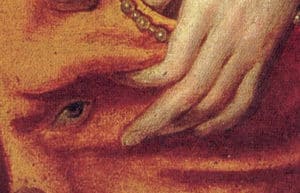
Speaking of vagina-like folds, the most obvious of those is the large one Elizabeth is touching with her left hand, as if to say, ‘insert phallus here’. (figure 27)
If you draw a line from the end of the rainbow to the vagina-like fold it passes over or through the loop of the long pearl necklace (a primary symbol of the queen’s virginity). As Fischlin noted, the loop is positioned roughly at Elizabeth’s crotch. (figure 28)
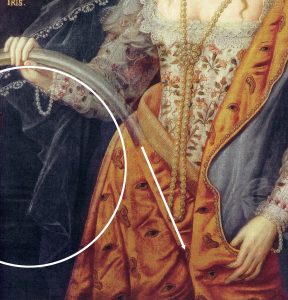
With the circle I mean to illustrate how the end of the rainbow deviates from the natural curve to point downward towards the vagina-fold. If the loop of the necklace is taken to represent Elizabeth’s actual vagina, the rainbow-phallus passes through and ruptures the hymen.
Symbolizing this, the loop of pearls at the bottom of the necklace are a dirty reddish brown. The discoloring is unmistakable, and otherwise unexplainable. Let us compare the necklace in the Rainbow Portrait with the same necklace in two other portraits of Elizabeth. Below, from left to right, are close-ups of the Rainbow, Hardwick, and Ditchley Portraits (figure 29): [68]
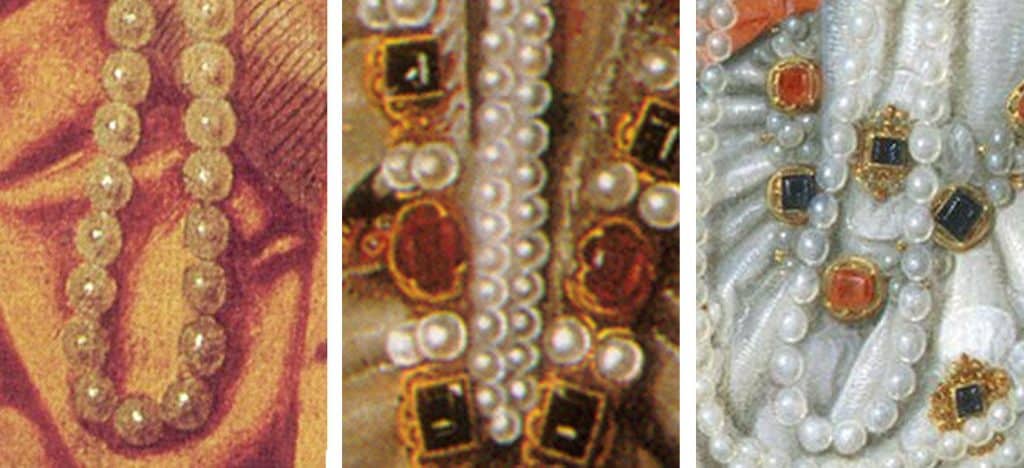
I’ve not found anyone else commenting on this. The sexually symbolic readings of Traub and Fischlin (dealing with the rainbow–phallus and the fold-mouth-vaginas) correspond more or less to my own interpretation, but we differ totally on the story they tell. In fact, for Traub and Fischlin these features and symbols don’t tell any story. Traub and Fischlin do not mention the soiled pearls or the implication of the bridal hat. They do not, per my reading of their commentaries, find anything in the painting that even nibbles at the question of Elizabeth’s virginity. If they did, that would open a horrifying can of worms for orthodoxy.
The Tubular Colorless Rainbow Phallus
To the sexual readings of Traub and Fischlin, we can add comments from Susan Frye:
… depicts an assemblage of iconographic elements that claim the queen’s chaste body as the center of the Ptolemaic universe while wrapping her in a mantle whose open mouths, ear, and eyes form a disquieting suggestion of vaginal openings combined with a sense of governmental surveillance.[69]
We can put aside the ‘governmental surveillance’ except to note that that is one of the major problems the scholars cannot solve. The problem is not simply that the rainbow is colorless. The tubular shape of the rainbow has been, as we have seen, commented on by a number of scholars. Some of what I am going to say will be redundant to what the scholars have said. This tubular or phallic shape is further suggested by the firm grasp of Elizabeth’s right hand. If you observe closely, Elizabeth’s fingers actually curve around the surface of the tube. From the position of the thumb and fingers as they arch forward around the tube, and the shadows of the fingers on the tube, this roundness is unmistakable (figure 30):
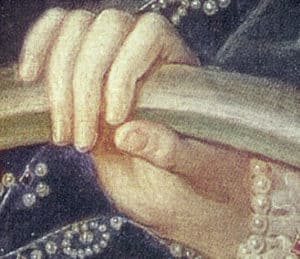
The tubular effect that most obviously gives the rainbow the look of a tube is the whitish highlight that runs laterally along the center from end to end. With the principal light source from in front of the sitter, this ‘reflection’ is exactly what we would expect to see on a plastic or glass tube.
Someone may argue that there is nothing to say that a rainbow must be flat and not tube-shaped. I grant that that is true, however, on the basis of the comments of various ‘experts’, I think it is fair to say that a tubular rainbow is counter-intuitive. However, I think there is sufficient agreement on this question to say, enough about the tube.
The Serpent
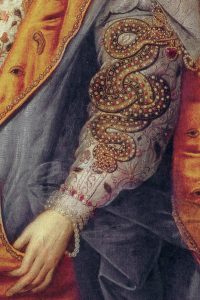
Frances Yates says (figure 31):
the serpent on the sleeve indicates her wisdom; and above the serpent’s head is the celestial sphere, [70]
Graziani follows Yates, saying:
For the serpent and the armillary sphere Ripa again provides Dr. Yates’s explanation; they are to be taken as attributes for ‘Intelligenza’. In the portrait they reflect the Queens’ wisdom in both the heavenly and earthy matters. For the red, heart-shaped jewel Dr. Yates refers us to Ripa’s figure Consiglio’ (Counsel) who has a heart among his attributes because the best counsel comes from the heart.[71]
This is the general consensus of scholarly guessing. There are lots of places, besides Ripa, where the serpent shows up as a symbol of wisdom; but, if we are talking about biblical symbolism, there is a problem. If we start at the beginning, with the story of Adam and Eve in the Garden of Eden, there is a Tree of Knowledge; the Tree of Knowledge of Good and Evil to be exact. In that story, the serpent is sly, that is, wise in an evil way. Biblically speaking, from the beginning, in the Garden of Eden, the serpent is regarded as the agent of sin; the devil in the form of a snake! Nowhere in the Old and New Testaments is the serpent spoken of as a symbol of knowledge or wisdom per se. In other traditions, that sly reptile managed to obtain a counter-intuitively respectable reputation as ‘wise’. For their interpretation of the rainbow the scholars draw on the biblical story of Noah and the flood. But, for the serpent, they have to put the Bible aside. In fact, if you follow biblical symbolism, it is difficult to devise a benign interpretation for that snake on the lady’s arm. Let’s assume, for the sake of argument, that the serpent is intended to be construed in biblical terms. What did the serpent do in the Garden of Eden? He tempted Eve and brought about ‘the fall’. The whole thing was Eve’s fault. The snake was just doing his job. Adam was an innocent bystander. Relax! I’m joking on all three counts. Some say ‘the fall’ has to do with carnal knowledge. Some say it has to do with ‘moral knowledge of good and evil’. If we take the Augustinian approach, there is something inherently sinful about sex. But once again I digress.
Let’s back up. If the serpent represents wisdom, what’s that big red jewel he’s making off with? Yates reaches over to Ripa’s figure ‘Consiglio’ (Counsel) where the heart shows up, per Yates, to mean that the “best counsel comes from the heart”. I have two objections. First, this romantic notion has hardly ever been the practice of governing monarchs. Quite the opposite. If Elizabeth had followed the ‘counsel of her heart’, presumably, she would have married Robert Dudley when she was obviously in love with him in the early years of her reign. Second, why is the ‘heart’ being stolen by a snake? How does that convey the concept of ‘counsel’? It doesn’t. It’s absurd.
I propose an interpretation that is consistent with common sense and biblical tradition, and which is consistent with the related symbols in the portrait. I quote Traub and Fischlin again (underline added):
Traub: “Grasping the phallus and touching herself, Elizabeth would seem to possess double access to pleasure.” [72]
Fischlin: “The portrait’s compositional balance entails an erotics in which the queen exerts control over the masculine, a control that may be further heightened by the sexual autonomy suggested in the positioning of her left hand.” [73]
We note where the lady’s left hand is ‘positioned, ‘touching herself’. The trajectory of the snake tells us where it is coming from. With a smidgen of imagination we can discern that the serpent (the agent of sin) has made off with something. What on earth could it be? Could it be the lady’s virginity? If you take what I’ve suggested you can logically tie all of this together: 1) the phallic symbolism; 2) the vaginal symbolism; 3) the symbolism of the snake; 4) the red jewel: 5) the bridal hat; 6) the soiled loop of pearls; 7) the eyes, ears and mouths on the inside of the cloak of secrecy; 8) and the inscription. All of it! And the simple story is: the lady in the portrait is a pretending virgin who has been hiding a son who would beautify her legacy if he were acknowledged.
The Rainbow Portrait Allusion in A Lover’s Complaint
What I am about to share with you has, to my knowledge, never before been detected or revealed. It is rather sensational, if I may say so myself. It is only part of what lays hidden in that little-valued poem of William Shakespeare’s with the innocuous title, A Lover’s Complaint (ALC). The true author, of course, was Oxford. It is, as the world will soon come to understand, one of his greatest works. It is probably the most revelatory, and with certainty, it is the most monumental, literally speaking. This is a glimpse at what Oxford concealed in that poem.
The primary purpose here is to show how ALC connects to the Rainbow Portrait. By way of allusion to that portrait, the poem incorporates the messages contained in the portrait and tells us that the poem is very much about Queen Elizabeth, the maid = maiden = virgin who had been Queen of England. Furthermore, the poem reveals more of the meaning of the portrait.
I cannot precisely limit my discussion to the Rainbow Portrait. In fact, ALC contains allusions to three other images of Elizabeth. For the purpose of the immediate discussion I shall confine my comments mainly to the Rainbow Portrait allusions. However, the other images of Elizabeth alluded to in ALC are these (figure 32):
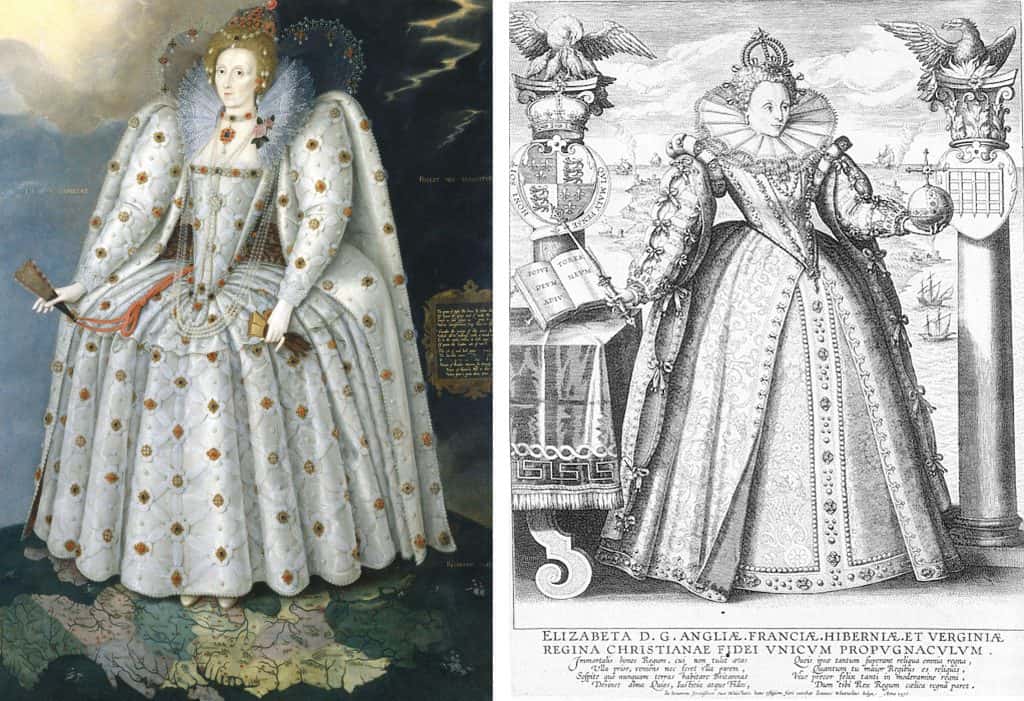
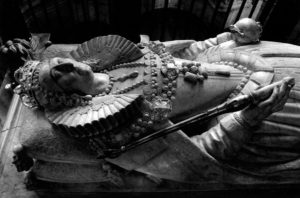
In the van der Pass engraving (what I call, the Tennis portrait), and the marble image (figure 33), note the ‘ball’ in Elizabeth’s left hand. In his provocative take-down of A Lover’s Complaint, Rosenbaum asks, “Are those Shakespeare’s Balls?” [74] The answer is: No. Those are Elizabeth’s balls. Rosenbaum missed ‘the signal’. That, ball, of course, is a Globus Cruciger (cross-bearing orb). So as not to keep the reader entirely in the dark, ALC begins with a reference to Queen Elizabeth packaged in a riddle:
From off a hill a concave womb reworded
A concave womb is a womb that is, figuratively, and on principle, not pregnant, like that of a virgin. The virgin spoken of here was, ‘From off a hill’, meaning she was away from the palace, in seclusion, where she ‘reworded’, meaning she gave birth. More than once. The word ‘reworded’ also means she ‘renamed’ her babies. Much of ALC, especially the opening stanzas, is about Queen Elizabeth who was, in 1608-9, well described in line 4 of ALC stanza 2:
(2) Upon her head a platted hive of straw,
Which fortified her visage from the sun,
Whereon the thought might think sometime it saw
The carcase of a beauty spent and done.
5 Time had not scythed all that youth begun,
Nor youth all quit, but spite of heaven’s fell rage
Some beauty peeped through lattice of seared age.
She was, after all, decaying in her tomb. That word ‘carcase’ is a very specific allusion to a notorious comment by the Earl of Essex regarding the queen. Edmund Malone does not mention the ALC allusion, but noticed a connection in The Tempest:
Prospero: A devil, a born devil, on whose nature
Nature can never stick; on whom my pains,
Humanely taken, all, all lost, quite lost;
And as, with age, his body, uglier grows,
So his mind cankers: I will plague them all,
Malone commented (underline added):
So his mind cankers:] Shakespeare, when he wrote this description, perhaps recalled what his partron’s most intimate friend the great Lord Essex, in an hour of discontent, said of Queen Elizabeth:— “that she grew old and canker’d, and that her mind was become as crooked as her carcase:”—a speech, which according to Sir Walter Raleigh, cost him his head, and which we may therefore suppose was at that time much talked of. This play [The Tempest] being manifestly written in the time of King James, these obnoxious words might be safely repeated.[75]
To which Boswell added:
I trust that Shakespeare did not aim a reproach at his queen and patroness in his grave.
It goes without saying that William Shakespeare “did not aim” any such “reproach”. Also, Wikipedia says:
In the summer [1598], during the Council debate over the appointment of the next military commander for Ireland, Essex turned his back on the Queen, and she lost her temper, striking him across the head. He laid his hand on the hilt of his sword, but was held back by the Lord Admiral. Before leaving the chamber Essex (again, according to Camden) said, “he neither could nor would put up so great an affront and indignity, neither would he have taken it at King Henry the Eighth his hands”. Tradition has it that he also called the Queen, “as crooked in her disposition as in her carcass”.[76]
To borrow a turn of phrase from Malone, lines 3-4 from ALC are ‘manifestly’ an allusion to Essex’s notorious comment some ten years later when Elizabeth’s ‘carcase’ was literally decaying in her tomb. However, seeking to confine my discussion to the Rainbow Portrait, the multi-part allusion thereto is found in ALC stanza 5:
(5) Her hair, nor loose nor tied in formal plat,
Proclaimd in her a careless hand of pride
For some, untuck’d, descended her sheav’d hat,
Hanging her pale and pined cheek beside;
Some in her threaden fillet still did bide,
And true to bondage would not break from thence,
Though slackly braided in loose negligence.
I will break this down; however, we first need to look back at the poet’s description of the maid in the first two lines of stanza 2:
[2] Upon her head a platted hive of straw,
Which fortified her visage from the sun,
Whereon the thought might think sometime it saw
The carcase of a beauty spent and done.
5 Time had not scythed all that youth begun,
Nor youth all quit, but spite of heaven’s fell rage
Some beauty peeped through lattice of seared age.
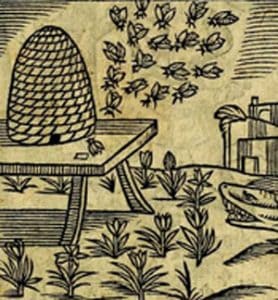
The maid, according to this description, is wearing a straw hat with a brim, but it is an odd hat, for a hive, or more specifically, a woven bee-hive, has no brim. Such a hive is called a skep. Here’s an image of skep from Peacham’s Minerva Britanna (figure 34):

A skep with a brim would look something like this (figure 35):
Pretty silly. This part of the description of the maid actually alludes to the Ditchley Portrait where Queen Elizabeth wears what appears to be a hive-like wig with a swarm of pearls that look like bees (figure 36):
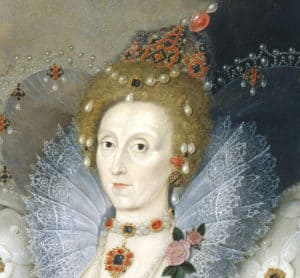
There was a particular type of wig at the time that was referred to as a ‘hive’. I think this particular wig in this portrait merely looks like a hive. There is more to that particular allusion in the Ditchley, but I’ll leave it there for now. We need to keep this part of the ‘hive-straw hat’ description in mind as we carefully consider how the poet describes the maid in stanza 5:
[5] Her hair, nor loose nor tied in formal plat,
Proclaimd in her a careless hand of pride
For some, untuck’d, descended her sheav’d hat,
Hanging her pale and pined cheek beside;
5 Some in her threaden fillet still did bide,
And true to bondage would not break from thence,
Though slackly braided in loose negligence.
If the maid is wearing a hive-like hat with a brim, how is her hat sheav’d? Sheaved and woven are not the same thing. And how is it that her hair ‘descended’ from her ‘hat’? We might accept a kind of sloppy description of the hat and imagine the maid’s hair flowing down from the hat along her cheeks, but that’s not how Oxford’s ‘science’ of concealed writing works. He gives you very specific provocative clues that are little riddles. You have to keep digging to find the true meaning. We come to lines 5-6 of stanza 5 (underline added):
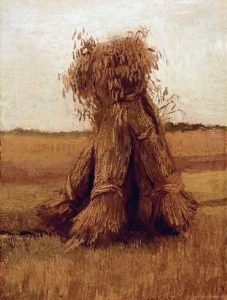
Some in her threaden fillet still did bide,
And true to bondage would not break from thence,
From the poet’s description, there are, evidently, strands of hair that are ‘bound’ and ‘descend’ from “her threaden fillet”. What the devil is a threaden fillet ? That proves to be somewhat interesting. But now we have a serious conflict with the hat. Before we get to the explanation for the threaden fillet, let’s consider the sheav’d hat. I suppose most people know what sheaves are. For those who don’t, they look like this (figure 37):
The verb, sheave, means ‘to gather, collect, or bind into a sheaf or sheaves (the noun)’. That is not a fitting description for a straw hat that looks like a bee hive with a brim. But the sheav’d description does fit, more or less, the brim of this hat (figure 38):
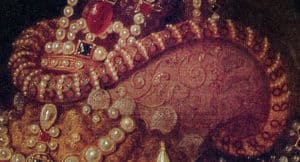
This ‘sheav’d hat’ actually suggests sheaving in two ways. In the rope-like brim the little strands of pearls bind the rope together in a sheav’d pattern. Also, the rope-like brim serves to bind the grassy blades (not easily seen) that shoot up and away from the crown. In the Rainbow Portrait we have, I propose, a sheav’d hat, or something close enough. How else does stanza 5 allude to the Rainbow Portrait? Pretty much all of lines 1-5 allude to the Rainbow Portrait, but as a description of the maid these lines are somewhat confusing and contradictory:
[5] Her hair, nor loose nor tied in formal plat,
Proclaimd in her a careless hand of pride
For some, untuck’d, descended her sheav’d hat,
Hanging her pale and pined cheek beside;
5 Some in her threaden fillet still did bide,
And true to bondage would not break from thence,
Though slackly braided in loose negligence.
There is ‘hair descending from the sheav’d hat’, which we’ve already discussed. Note the word descended in line 3. And there is hair ‘hanging along her cheek’ (three strands of hair descend, as heirs descend), though some of her hair remains ‘bound’ in her ‘threaden fillet’. What is that about? To understand that we need to know what a threaden fillet is. What it is, is a clever but somewhat technical way of referring to a particular style of wig. But, to be honest, this had me stumped for quite a while. At Dictionary.com, I found this as the second definition of fillet as a head garment:
A narrow band of ribbon or the like worn around the head, usually as an ornament; headband.
That wasn’t much help. I couldn’t see how to combine that with the brimmed hive-like sheav’d hat. But, after much searching, I learned that fillet is a term applying to a particular Roman style of wig. And, in my searching, I stumbled into a beehive, figuratively speaking. We go to Wikipedia and an article titled ‘Roman Hairstyles’.[77] Here are some excerpts which, so that the reader may be instructed, I quote at length (bold added):
Styles over time
Roman hairstyles changed, but there were several constant hairstyles that were used continuously, such as the tutulus, or the bun. The beehive, helmet, hairbouquet or pillbox are modern day names given to Roman hairstyles.
Tutulus
The tutulus, originally an Etruscan style worn commonly in the late 6th and early 5th century BCE, was a hairstyle worn primarily by the materfamilias, the mother of the family. It remained in constant use even when fashion changed. To achieve it, the hair was divided and piled high and shaped into a bun, after which it was tied with purple fillets of wool. By the end, the hair would be conical in shape. It was also the hairstyle worn by the flaminicae.
Vittae were woollen fillets that bound a married woman’s hair. They were another indication of a wife’s modesty and purity and were seen as part of the clothing and presentation of a matron. Vittae could be inset with precious stones, or in the case of the Flaminicae, they would be purple in colour.
There were two types of wig in Roman times: the full wig, called the capillamentum, and the half wig, called the galerus. The galerus could be in the form of a fillet of woolen hair used as padding to build an elaborate style, or as a toupee on the back or front of the head. Toupees were attached by pins, or by sewing it onto a piece of leather and attaching it as a wig. Further, glue could be used to affix it to the scalp or alternatively, as a bust from the British Museum illustrates, the toupee could be braided into the existing hair.
Flavian and Antonine hairstyles are perhaps the most famous, and extravagant, of Imperial Rome’s styles. During this time the aristocratic women’s style became the most flamboyant. The styles were lofty, with masses of shaped curls and braids. The high arching crowns on the front were made using fillets of wool and toupees, and could be attached to the back of the head as well as the front. Typically, as in the case of the famous Fonseca Bust (pictured), this particular hairstyle appears to have been popular during the Flavian period. The hair was combed into two parts; the front section was combed forwards and built with curls, while the back was plaited and coiled into an elaborate bun. This fashion was described by the writer Juvenal as the hairstyles that made women appear tall from the front but quite the opposite from the back.
Here’s a well-known sculpted example of a wig with a threaden fillet (figure 39):
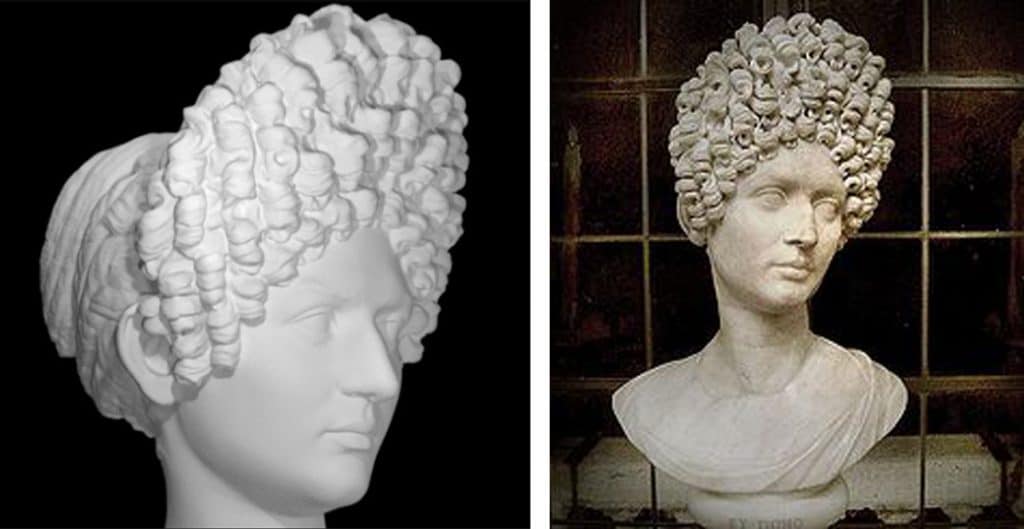
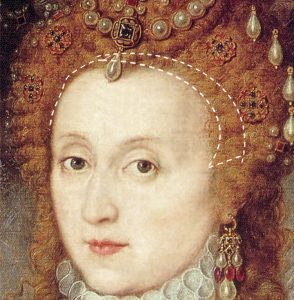
That is what I call, ‘hard’ evidence. Below we see how Elizabeth’s wig mimics the hair style of the Fonseca bust with its invisible threaden fillet (approximated by the parallel arcs I’ve inserted) (figure 40):
In an allegorical portrayal of Elizabeth’s death (evidently from the 19th century) there are three of Elizabeth’s lady’s all wearing the same style of wig (figure 41):[78]
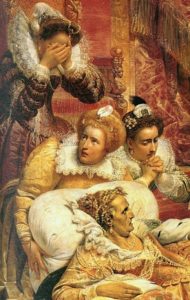
My point with the painting above is to give another view of this particular wig style. Here, once again, is that curious stanza from ALC with the key elements of the allusion underlined:
[5] Her hair, nor loose nor tied in formal plat,
Proclaimd in her a careless hand of pride
For some, untuck’d, descended her sheav’d hat,
Hanging her pale and pined cheek beside;
5 Some in her threaden fillet still did bide,
And true to bondage would not break from thence,
Though slackly braided in loose negligence.
Three stands of hair (three heirs; her three descendants) descending along her cheek and from behind onto her breast (figure 42):
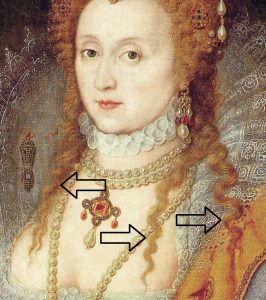
So, we have a quick picture of the allusion to the Rainbow Portrait which allows us to understand what stanza 5 is saying. And, just a reminder, without immaculate conception (or adoption), virgins don’t have heirs.
A Pink Carnation
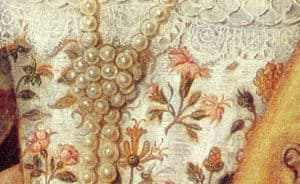
There are various flowers on Elizabeth’s bodice and sleeves. According to Susan Frye (figure 43):
For the floral decoration on the bodice and sleeves (Dr. Yates observes roses, pansies, honeysuckle, cowslips) are wild-flowers ‘that sprang unplanted’ in the Golden age (Metamorphoses, i. 107-8).[79]
Each of the flowers may have a significant meaning in this portrait. However, I think it is fair to focus on one—the one closest to Elizabeth’s heart, literally, that Frye fails to mention.
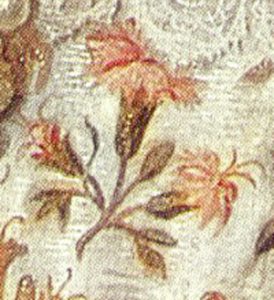
The flower nearest to Elizabeth’s heart is, I’m pretty sure, a pink carnation (figure 44). It is sometimes called a gillyflower. If the large bloom at the top were a babe, it would seem almost to suckle on Elizabeth’s breast. No accident I think. As painted, this little sprig of carnations appears, at first glance, to have three flowers in various stages of bloom, one or perhaps three buds, and a set of leaves nearest the base on the left. However, if this is a carnation, the leaves should be sword-shaped and begin lower on the stem. Allowing that, in any case, there may be a degree of artistic license in play, and since I have not had the opportunity to inspect the carnation up close, I will leave the detailed meaning open. But, what is the most direct meaning of this pink carnation with its preeminent and suggestive location in this portrait? From Wikipedia:
According to a Christian legend, carnations first appeared on Earth as Jesus carried the Cross. The Virgin Mary shed tears at Jesus’ plight, and carnations sprang up from where her tears fell. Thus the pink carnation became the symbol of a mother’s undying love.[80]
This is coincidentally appropriate to my thesis. Oxford’s royal identity, and his identity as an author, were sacrificed, almost literally, on the altar of his mother’s reputation as the Virgin Queen. Oxford was a martyr for his mother’s sake. She would have said (arguing on the basis of ‘precept’), ‘for England’s sake’. The pink carnation straining to Elizabeth’s breast is Oxford straining in vain for his mother’s love. To the very end he refused to give up.
Oxford’s was not the greatest personal tragedy in the history of the world, but his does fall within a special category. There is no greater violation of the sacred than a mother’s betrayal of her children by denying them her love. That, and Elizabeth’s excuses, the ‘precepts’ she shielded herself with, and by which she destroyed her son, are the story told in stanza 39 of A Lover’s Complaint, which, in my opinion, is the best and most powerful poetry in the poem. Here is stanza 39 (trust me on this: Love and Motherhood are synonymous):
[39] When thou impressest, what are precepts worth
Of stale example? When thou wilt inflame,
How coldly those impediments stand forth
Of wealth, of filial fear, law, kindred, fame!
5 Love’s arms are peace, gainst rule, gainst sense, gainst shame,
And sweetens, in the suffering pangs it bears,
The aloes of all forces, shocks, and fears.
‘Filial fear’ is usually taken as fear of a parent. Here it means fear of being a parent. The stanza is an anguished complaint from a son who wanted to love his mother and be loved by her. Elizabeth was dead. In the end, with the finality of her death, she rejected his love. Dwindling hope gave way to bitter resignation. No son? No rainbow! As he lay dying, Hamlet said to his dying mother:
Wretched queen adieu! …Had I but time …O, I could tell you . . .
And O, he did!
A Cloak of Secrecy — Conclusion
I do not assume that I have convinced the reader that the Rainbow Portrait is a Trojan Horse, or that A Lover’s Complaint is O’s complaint about his mother. Obviously I do so hope. On the assumption that the reader is not convinced on either account, I will conclude here with a kind of summation that, perhaps, the reader will give further consideration.
How plausible is the proposition that Robert Cecil was involved in the conception and commissioning of that portrait? I say, merely on the basis of ambiguity and the very special potential of this portrait to be construed in less than benign ways, Robert Cecil’s complicity must be ruled out. The question then is, who was the person behind the portrait, and what was his motive? And I say the scholars have not given this an iota of thought. If they did, they would have to think outside of the box, that is, think out of the conventional interpretive context that confines their thinking. It is impossible. Within that academic specialty the barriers to thinking are perfect. We have centuries of proof.
For the same reason, these so-called experts, who have studied the symbolism of the portrait from every angle, have been blind to one of the portrait’s most obvious and most important symbolic messages, that the cloak is a cloak of secrecy. It doesn’t take a PhD in renaissance symbolism to spot this. Therein is the explanation for the eyes and ears and mouths that they have been unable to explain, and unable to align with any iconographic precedent, and unable to fit to their interpretive context.
What is their explanation for the bridal hat? ‘Composite’ ‘hybrid’ imagery for decoration’s sake. What is their explanation for the ‘phallic rainbow’ and ‘vaginal folds’? I honestly don’t know. What motive, what purpose is there for those dangerously problematic symbols? They don’t even pose the questions. What is their explanation for the soiled pearls at the bottom of the necklace? Nothing. As with the obvious fact that eyes, ears, and mouths are on the inside of her clothing, they don’t even notice. They don’t notice! I’m just an amateur literary-historical sleuth. Certainly not a ‘professional scholar’. But I did notice.
In closing, I come back to my caveat about Robert’s Cecil’s motives. Though it is merely an idea, and clearly counter-intuitive, I want to pose the possibility that Cecil did, in fact, understand the hidden meaning of the portrait. That would mean that he was, in collaboration with Oxford, leaving the door open for the possibility that Elizabeth might acknowledge her children. There was no way for Cecil to be sure she wouldn’t. It must have been clear that Elizabeth’s health was declining fast. If, before she died, she had acknowledged Oxford as her son and recommended him as her successor, and (the big if) if evidence of Oxford’s ‘lawful’ birth was presented, it would have been up to the Privy Council to decide. Given Elizabeth’s long-established reputation as a virgin, and numerous other problems, this would have been a highly problematic political gambit, but many may have viewed it preferable to ending the Tudor dynasty and electing a non-Englishman king of England.
Oxford may have had a less than stellar reputation, but, looking back over the succession of English kings, that was seldom a deciding factor. The worst case would have been to leave the matter open to competing contenders who lacked clear rights of succession. In terms of ensuring the continuation of Protestant rule, Oxford would likely have seemed like the best bet. Moreover, extending the Tudor legacy of Elizabeth would surely have had considerable appeal. Robert Cecil’s highest priority was undoubtedly looking out for Robert Cecil and his family. But he was a pragmatist and an excellent judge of the political realities. Therefore I do not rule out that he was working to ensure his future under either eventuality.
However, as I said, Oxford’s objective may have been simply to be acknowledged as the ‘son’.
Notice: If you like to tell me what you think of this, good or bad, or carry on the discussion, feel free to contact me: steinburg@t-online.de
Oxfordian Steven Steinburg is the author of I Come to Bury Shakspere.
ENDNOTES
[1] Strong, Roy. Gloriana, The Portraits of Queen Elizabeth I. Thames and Hudson, 1987. Page 175.
[2] Traub, Valerie. The Renaissance of Lesbianism in Early Modern England. Cambridge UP, 2002. Page 136-7.
[3] Strong, Roy. Shakespeare’s Visual Theater. Cambridge UP. 2003. Page 78.
[4] Rosenbaum, Ron. ‘Are Those Shakespeare’s Balls”? Should A Lover’s Complaint be kicked out of the Shakespeare canon?’ http://www.slate.com/articles/life/the_spectator/2008/06/are_those_shakespeares_balls.html 6 January, 2016: https://en.wikipedia.org/wiki/A_Lover’s_Complaint
[5] Vickers, Brian. « Did Shakespeare write A Lover’s Complaint? », Actes des congrès de la Société française Shakespeare, 24 | 2007, 69-96. https://journals.openedition.org/shakespeare/1026#quotation
[6] Yates, Frances. Astraea, Selected Works of Frances Yates Volume V. Routledge, 1975. Pages 220-1.
[7] To be absolutely accurate, Yates says this headdress is “supposed by Boissard to be that worn by a bride”.
[8] Graziani, René. ‘The ‘Rainbow Portrait’ of Queen Elizabeth I and its Religious Symbolism’. Journal of the Warburg and Courtauld Institutes, Vol. 35 (1972), page 247-259 (15 pages). Page 247.
[9] Traub. Pages 136-7.
[10] Fischlin, Daniel. ‘Political Allegory, Absolutist Ideology, and the “Rainbow Portrait” of Queen Elizabeth I’.
Renaissance Quarterly, Vol. 50, No. 1 (Spring, 1997), pp. 175-206.
[11] Fischlin. Page 184.
[12] As printed by J. B. Nichols in 1868.
[13] Diary of John Manningham, ‘edited from the original manuscript by John Bruce’. J. B. Nichols and Sons, 1868. Pages 99-100. https://archive.org/details/diaryofjohnmanni00mannrich/page/100
[14] Nicoll, Allardyce, editor. Shakespeare Survey 15, Cambridge UP, 1962. Page 103.
[15] Erler, Mary C. ‘Sir John Davies and the Rainbow Portrait of Queen Elizabeth’. Modern Philology, Vol. 84, No. 4 (May, 1987) pp. 359-371. U of Chicago Press. Page 367.
[16] Fischlin. Pages 177-8.
[17] Fischlin. Page 178.
[18] Fischlin. Page 178.
[19] Fischlin. Page 178.
[20] Fischlin. Page 178.
[21] Fischlin. Page 181.
[22] Fischlin. Page 185.
[23] Fischlin. Page 186.
[24] Fischlin. Page 184.
[25] Fischlin. Page 184.
[26] Fischlin. Page 184.
[27] Fischlin. Page 182.
[28] https://archive.org/details/gri_33125008666188/page/n192
[29] Erler. Page 359.
[30] Erler. Page 367.
[31] Erler. Page 367.
[32] Erler. Page 367.
[33] Erler. Page 376.
[34] Erler. Page 369.
[35] https://en.wikipedia.org/wiki/Portraiture_of_Elizabeth_I_of_England
[36] Strong. Gloriana. Pages 158-9.
[37] Kiefer. Page 78.
[38] Kiefer. Page 78.
[39] Roberts, Helene E, editor. Fitzroy, Dearborn. 1998.
[40] Strong. Gloriana. Pages 158-9.
[41] https://en.wikipedia.org/wiki/Cesare_Ripa
[42] https://archive.org/details/iconologiaormora00ripa/page/n7
[43] https://archive.org/details/iconologiaormora00ripa
[44] Strong. Gloriana. Page 159.
[45] Nichols, John. The Progresses of and Public Processions of Queen Elizabeth. Vol 3. John Nichols and Son, London. 1823. Page 76. https://archive.org/details/progressespublic03nichuoft/page/76
[46] The Penny Magazine of the Society for the Diffusion of Useful Knowledge, 1893, Charles Knight and Co. London. Page 407. https://books.google.de/books?id=zHdMAAAAMAAJ&pg=PA407&lpg=PA407&dq=john+davies,+%E2%80%98many+things+she+sees+and+hears+through+them,+but+the+Judgment+and+Election+are+her+own%E2%80%99.&source=bl&ots=UXm4bOnugD&sig=VPcdJDt0RJf7DtOkxZ1618bWw0M&hl=en&sa=X&ved=2ahUKEwjutaLbqYbeAhUQJhoKHVhHDAgQ6AEwAXoECAkQAQ#v=onepage&q=john%20davies%2C%20%E2%80%98many%20things%20she%20sees%20and%20hears%20through%20them%2C%20but%20the%20Judgment%20and%20Election%20are%20her%20own%E2%80%99.&f=false
[47] Chambers, Edmund. The Elizabethan Stage, 1923. Vol 3. Page 249.
[48] Erler. Page 369
[49] https://en.wikipedia.org/wiki/Secretary_of_State_(England)
[50] Wiggins, Martin and Catherine Teresa Richardson. British Drama, 1533-1642: A Catalogue, Volume 4. 2011. Page 435.
[51] As conventionally understood from the title of the poem as it appeared in the 1645 collection of Milton’s poems.
[52] https://en.wikipedia.org/wiki/John_Davies_(poet)
[53] Wilson, Christa. ‘Beyond the Mask: Stratregic Symbolism in the Rainbow Portrait’. CLA Journal, 4 (2016), pp. 219-232. Page 229. http://uca.edu/liberalarts/files/2016/08/2016-13-Wilson-Beyond-the-Mask.pdf
[54] Wilson. Page 229.
[55] Graziani. Page 259.
[56] I attributed Amoretti to Oxford.
[57] https://en.wikipedia.org/wiki/Treasons_Act_1571
[58] Thomas Regnier, ‘Did Tudor Succession Law Permit Royal Bastards to Inherit the Crown?’ https://shakespeareoxfordfellowship.org/wp-content/uploads/Regnier.TudorSuccessionLaw.pdf
[59] William Camden, The Historie Of The Most Renowned And Victorious Princess Elizabeth, Late Queene of England (1630).
[60] See Wikipedia: https://en.wikipedia.org/wiki/William_Camden
Here is an excerpt: “In 1597, William Cecil, 1st Baron Burghley suggested that Camden write a history of Queen Elizabeth’s reign. The degree of Burghley’s subsequent influence on the work is unclear …The first translation into English of books 1-3 appeared in 1625, done by Abraham Darcie …Book 4 was translated into English by Thomas Browne, canon of Windsor, in 1629.”
What is “clear” is that, to write such a “history”, Camden would have needed access to the royal archives. Access to the archives was controlled by the Lord Secretary, William Cecil, and later his son, Robert Cecil (and later by Robert Cecil’s successor). Such access would only have been granted with the understanding that Camden’s “history” would say what the Cecil’s wanted it to say. Fulke Greville reports in his ‘Life of Philip Sidney’, that Robert Cecil denied him access to the archives.
[61] The marriage of Princess Elizabeth required the approval of her younger brother, King Edward VI.
[62] Private email of 13 August 2019. Re: ecclesiastical law on marriage, see Sokol, B.J. and Mary, Shakespeare’s Legal Language: A Dictionary (New Brunswick, NJ: The Athlone Press, 2000), pp. 289-307 (section on “pre-contract”).
[63] When Oxford’s birth was announced in 1550, Dudley may have felt that he was ‘off the hook’.
[64] Not to be confused with Francis Walsingham.
[65] Anderson, Mark. Shakespeare By Another Name. Gotham. New York. 2005. Pages 175-6.
[66] Weir, Alison. The Life of Queen Elizabeth. Vintage. Originally published in 1998. I’m quoting from the 2008 paperback edition. Page 135.
[67] The term ‘Lord Protector’ was later adopted for Oliver Cromwell who declined to serve as king. Cromwell served under the title: Lord Protector of the Commonwealth of England, Scotland and Ireland from 1653-58. His son bore the title from 1658 to 1559.
[68] Images above from Wikipedia: https://upload.wikimedia.org/wikipedia/commons/c/cf/Elizabeth_I_Rainbow_Portrait.jpg
[69] Frye, Susan. Elizabeth I: The Competition for Representation. Oxford UP, NY. 1993. Pages 102-3.
[70] Yates, Frances. Astraea, Selected Works of Frances Yates Volume V. Routledge, 1975. Pages 220-1.
[71] Graziani. Page 248.
[72] Traub. Page 136-7.
[73] Fischlin. Page 187.
[74] Rosenbaum, Ron. ‘Are Those Shakespeare’s Balls’. http://www.slate.com/articles/life/the_spectator/2008/06/are_those_shakespeares_balls.html
[75] The Plays and Poems of William Shakespeare, with Corrections and Illustrations of Various Commentators [William James Boswell, Edward Capell, Alexander Pope, George Steevens, Samuel Johnson, Richard Farmer, Nicholas Rowe.], Comprehending A Life of the Poet and an Englarged History of the Stage. By the late Edmond Malone. Volume 15. C. W. Baldwin, printer. 1821. Pages 151–2.
[76] https://en.wikipedia.org/wiki/Essex_in_Ireland
[77] https://en.wikipedia.org/wiki/Roman_hairstyles
[78] https://en.wikipedia.org/wiki/File:Elizabeth_I_Death.jpg
[79] Frye. Pages 107-8.
Membership dues cover only a fraction of our budget, including all our research, preservation and programming. Please support the SOF by making a gift today!
Blue Boar Tavern: Wassail Q&A
Tuesday Dec. 17, 8pm E / 5pm P
Sign up below for event invites!
